
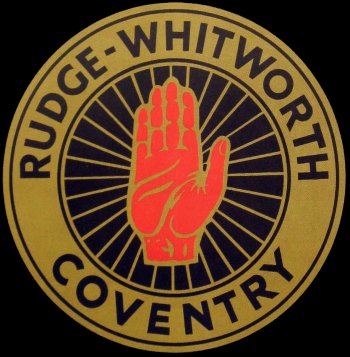



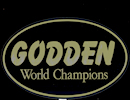

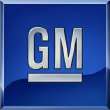 |
|
| |
| |
Miscellaneous
Part 4 |
| |
| |
Putt Mossman
Pre War Helmet Colours
Concrete/Tarmac Starting Area
Old Bike Makes Jack
Sharp in Singapore
Jack and Frank Chiswell
Rocket Bike
Speedway & Ice News 1952 Mags for
Sale
Polish Touring Party |
|
Victor Mucha Russian Daredevil
Alex Faulkner's Autograph Book
Cec Warren's 1928
Scrapbook Italian Tourist Party
|
| |
| Speedway Bike Transportation |
| |
| Since becoming interested in speedway
during 1961. I
have developed an interest in the modes of transport employed in
getting a rider and his bike(s)/equipment around the tracks.
In the modern era all riders
appear to have at least two bikes, a large van and a load of equipment
with them at every meeting.
This wasn’t the case years ago.
|
| |
| The early pioneers in 1928-1929
would set off for a race meeting on their street legal bikes to
the track and then in the pits proceeded to strip the bike down,
removing mudguards, lights etc and were also instructed by early
dirt track racing rules to disable the brakes.
Then the riders took to the track on their stripped down
machines. At the end of the racing the rider would refit all the
parts removed, reconnect the brakes and ride the bike home.
Modern riders have it so much easier with mechanics
and a large van. |
| |
| Most tracks used to have a "Track Spare"
which could be used in an emergency if the rider wrecked their
bike or had serious running problems. The track spare
usually started off the season in good running order but was often
plundered by a rider in difficulties taking parts off it to keep
his own bike going leaving the spare in a state of disrepair.
As a result the "Track Spare" idea was done away with over the
years. |
| |
| |
| 1930's Mode Of Transport |
| |
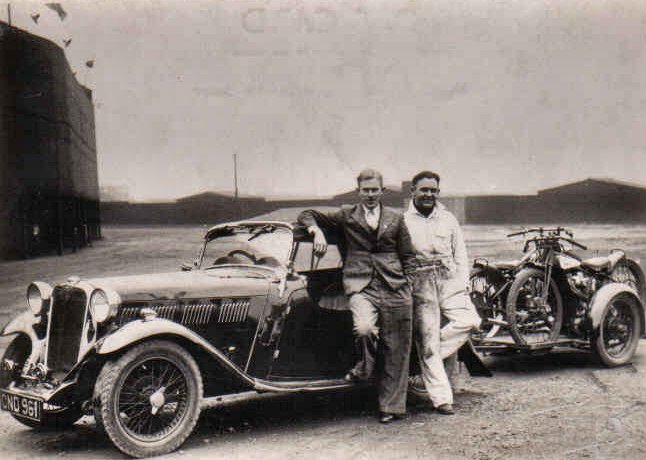 |
| |
|
This is Canadian Eric Chitty and his mechanic at West Ham in
the 1930's. He was a very successful rider hence he could
afford the sports car, trailer and two bikes. |
| |
| Car/Van ownerships were often not affordable to young
riders starting out on their speedway career whereas a motorcycle/sidecar
combination was more affordable, I am showing below how this, the
most basic transport, was used by many young riders aspiring to
the level of Eric Chitty |
| |
| |
1948 Typical
Junior Rider Transport |
| |
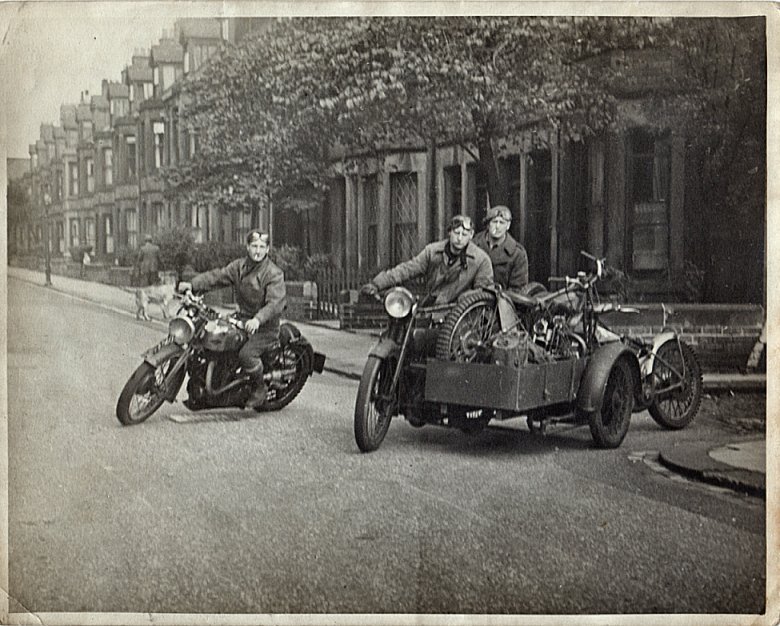 |
| |
| This photo was taken in Wallsend close to Newcastle's race
track Brough Park. It was taken in 1948 and shows novice rider
John Hunter and friends on their way to Brough Park. |
| |
| The guy on the left was another rider Stuart Robson, no relation
to the 2013 Newcastle rider by same name. The combination
was a 1923 Harley Davidson. I don't know what the other road
bike was. The speedway machine in the sidecar was I am told
a Rudge with a JAP engine. The other speedway bike has it's
chain removed so the back wheel could revolve freely on the road.
It was common to see speedway bikes transported in this fashion
before car/van ownership did away with the motorcycle
combination. A notable "Name" Reg Fearman, started his
riding career this way. |
| |
| |
| Reg Fearman's Humble
Beginning |
| |
.jpg) |
| Courtesy of Reg Fearman |
| |
| My friend Reg Fearman used the above pictured
sidecar combination
when he was riding in Australia in 1950/51 The workhorse machine
was a Panther 650cc, a far cry from Reg's Rolls Royce's which he
owned when he was promoting in the 1960/70s in the UK. |
| |
| |
| The Small Van |
| |
| Owning a small van big enough for one
bike was looked upon as a huge improvement over the bike/sidecar |
| |
 |
| Courtesy of Reg Fearman |
| |
| Reg Trott with his van at Rye House in 1950's, looking
very happy as he loads his bike into a strange looking vehicle, it
appears to have a rear door that becomes a ramp when let down and
partly wooden in construction, unless I am wrong. |
| |
| |
| Bike In The Boot! |
| |
 |
| |
| This is Ronnie Genz an Oxford rider when this picture was
taken. Incredible now having a motorbike sticking out of a
boot. But in the 1960s many riders travelled this way.
The boot would be tied down to stop the wind catching it and the
police were happy with it! All you needed was a biggish
family saloon with a good sized boot like this Mark 1 Ford
Cortina. Another good car for a speedway rider was the
Citroen Safari you could get a bike right inside and shut the
tailgate. I remember New Zealander Graeme Stapleton using
one when he rode for my team Newcastle in the 1970s. |
| |
| |
Tow Bar Mounted
Bike Racks |
| |
 |
| |
| If you had a large car or van with a tow
bar fitted. You could take of the ball end off the tow bar
and bolt a bike rack |
| on in its place. A bike would sit
securely on the bike rack as shown above. |
| For many years speedway bikes were transported either
sticking out of the boot of large cars or like this one slung on a special
rack mounted on a tow bar. This rig belonged to Cliff Watson.
I borrowed a bike rack in 2005 from local Newcastle rider Craig
Connon when he lent me his bike to put on show at a local
motorbike carnival. |
| |
| |
| Ernst Bøgh's Retro JAP On A Tow Bar Bike
Rack |
| |
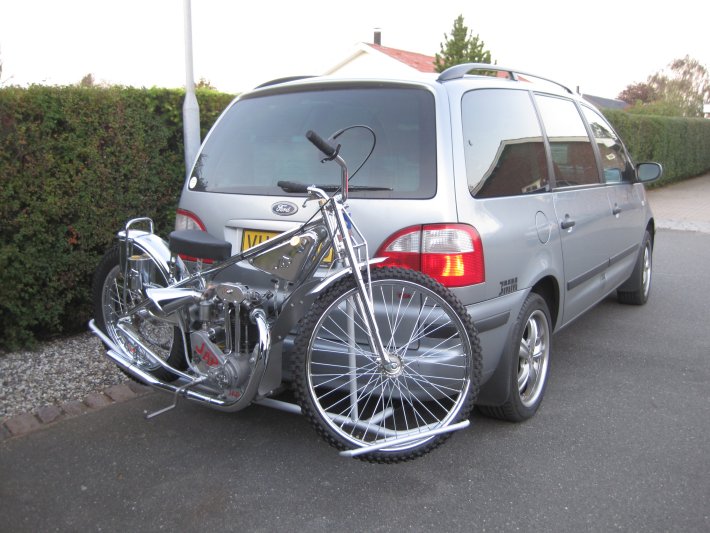 |
| |
| Danish Rider Ernst Bøgh has sent this pic of a
Retro Rotrax JAP mounted on a bike rack. Although the
picture is recent, this kind of bike rack has been around for
decades. The rack fits onto a tow bar mounting and the bike is lifted
on and secured by aerolastics and a number plate/lights board. Do
it right and you can cruise at top speed, well 70mph in the UK! |
| |
| John says: This is an
interesting topic if you have any pictures showing a riders chosen
novel method of transport please send me your pics and/or your views on
what is shown in this section email me here
John |
| |
| It never ceases to amaze me that most
riders turned up for matches despite the various difficulties they
faced in years gone by. Not many motorways, dual
carriageways and less than reliable modes of transports!
Well done guys |
| |
| |
|
| |
| |
| |
Les Drury's Newspaper
Researches |
| |
| 84,000 at Wembley |
| |
| England v Australia |
| 1932 |
| |
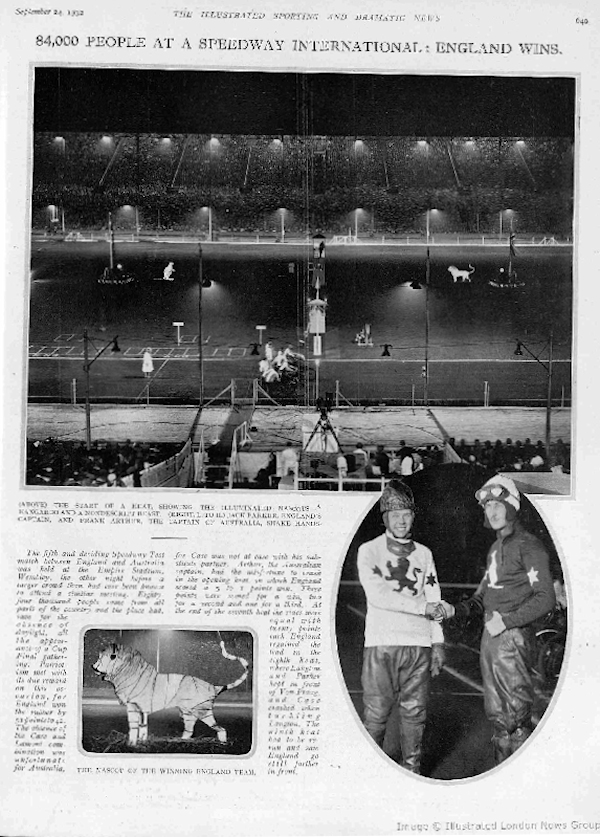 |
| Courtesy of Les Drury |
| |
| |
| Lady Riders |
|
1929 |
| |
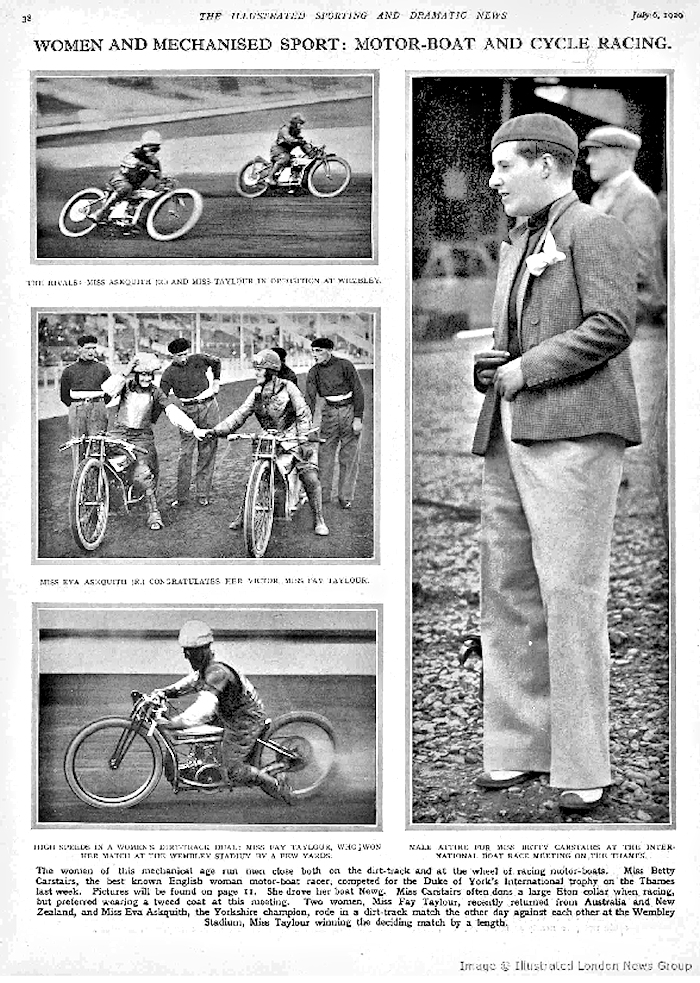 |
| Courtesy of Les Drury |
| |
| |
| Wembley Test |
| |
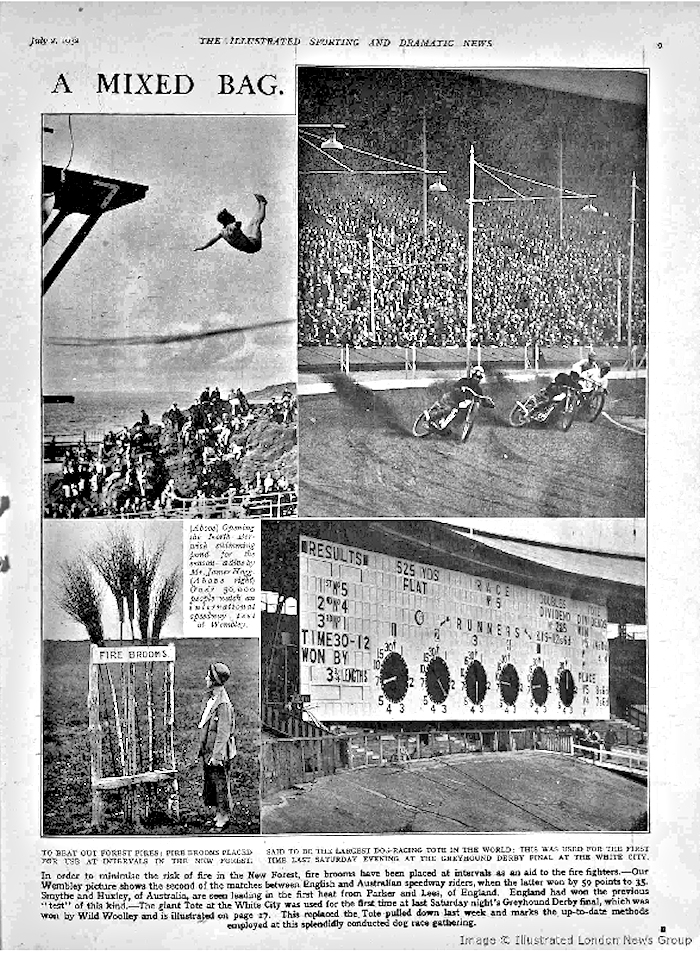 |
| Courtesy of Les Drury |
| |
| |
| Motorcyclists and Airmen |
| 1940 |
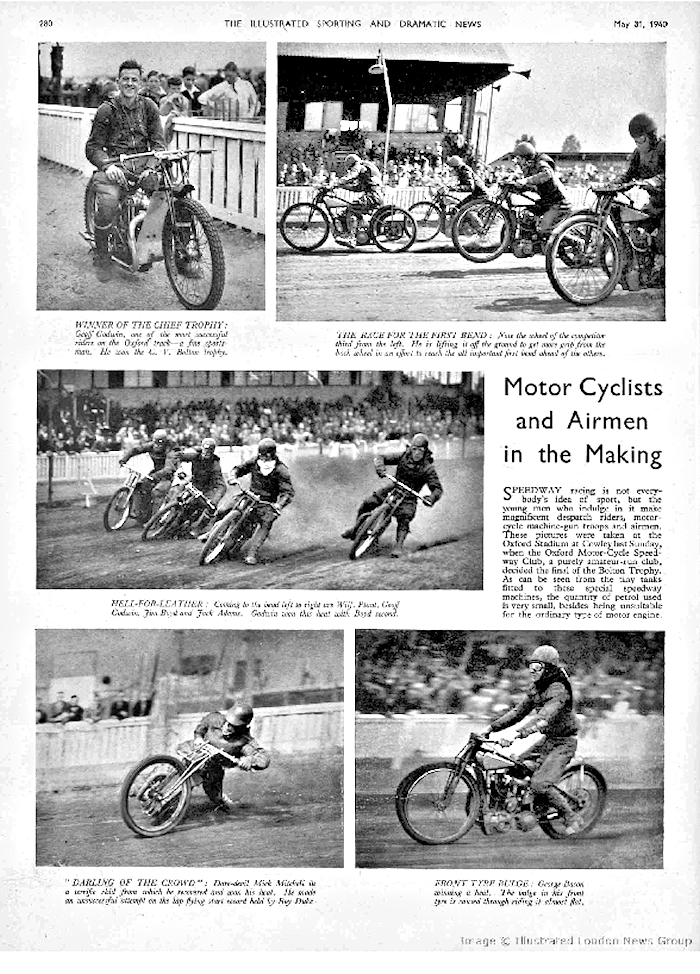 |
| Courtesy of Les Drury |
| |
| |
| The America's Cup &
High Beech |
| 1930 |
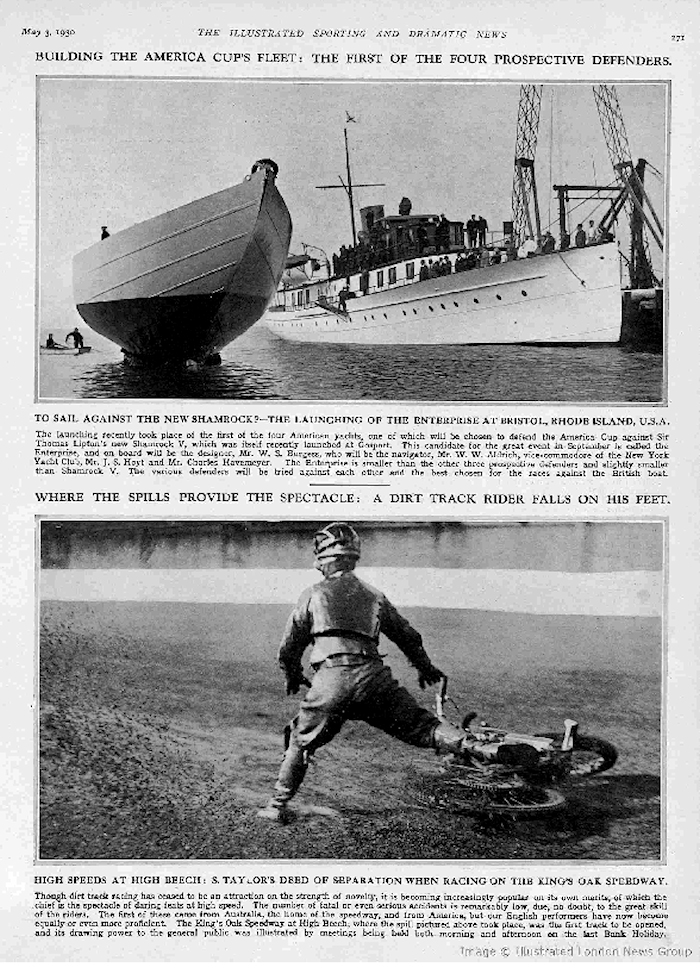 |
| Courtesy of Les Drury |
| |
|
| |
| |
Alex Faulkner's
Pre War Autographs |
| |
| |
| L Stanger |
| |
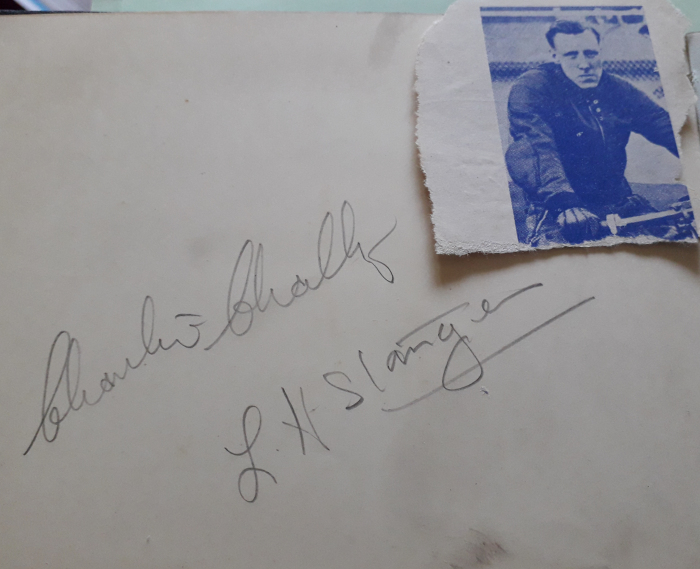 |
| |
| |
| Les Bowden |
| |
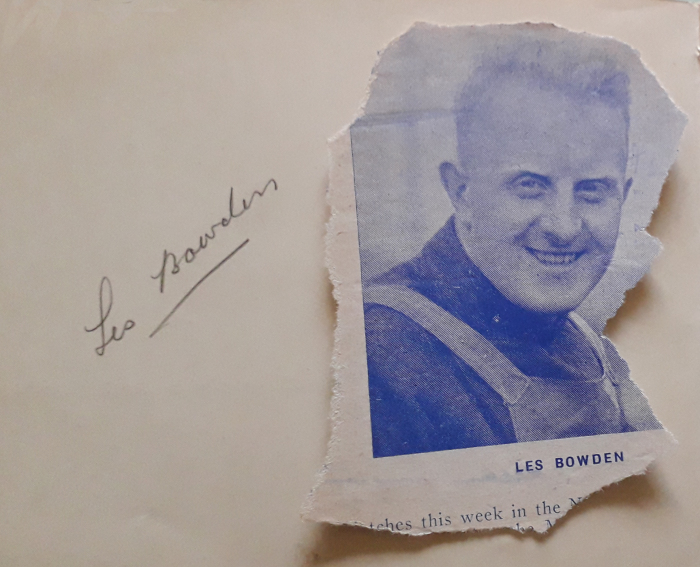 |
| |
| |
| Keith Harvey |
| |
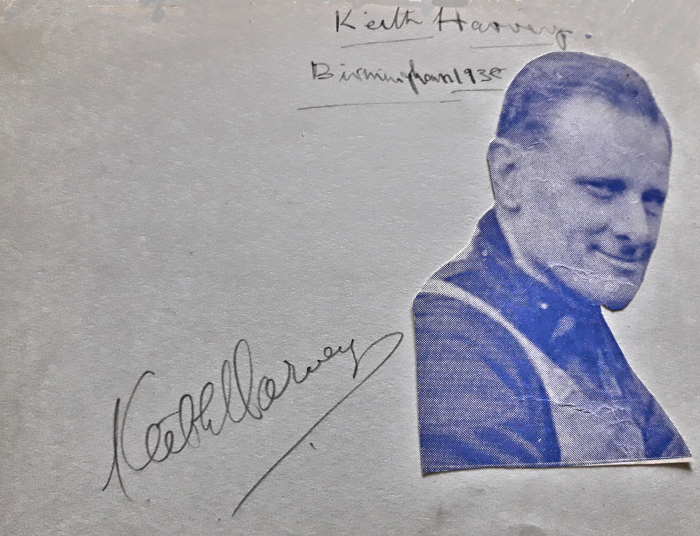 |
| |
| |
| Bob Lovell |
| |
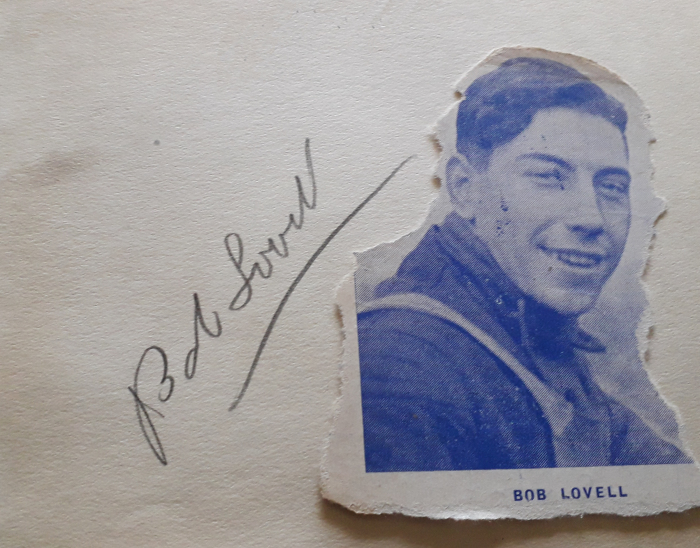 |
| |
| |
| Ted Bravery |
| |
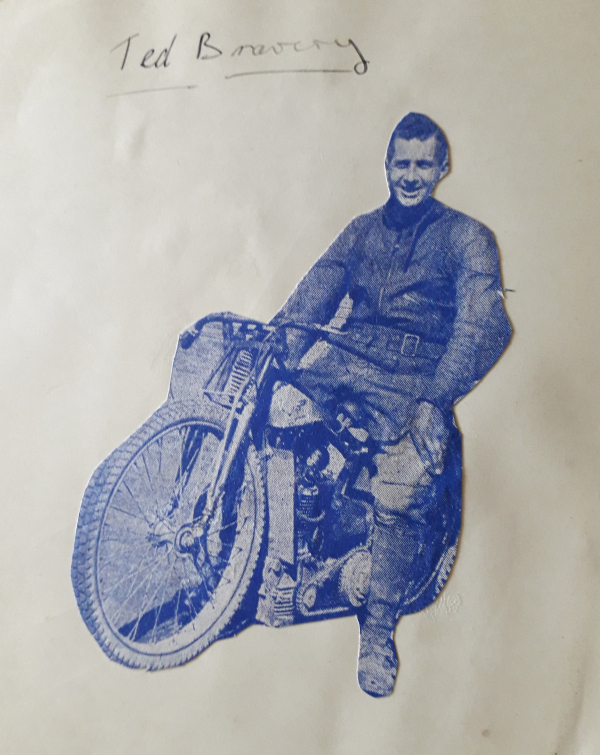 |
| |
| |
| Steve Langton |
| |
 |
| |
| |
| Stan Lemon |
| |
 |
| |
| |
| Bluey Wilkinson |
| |
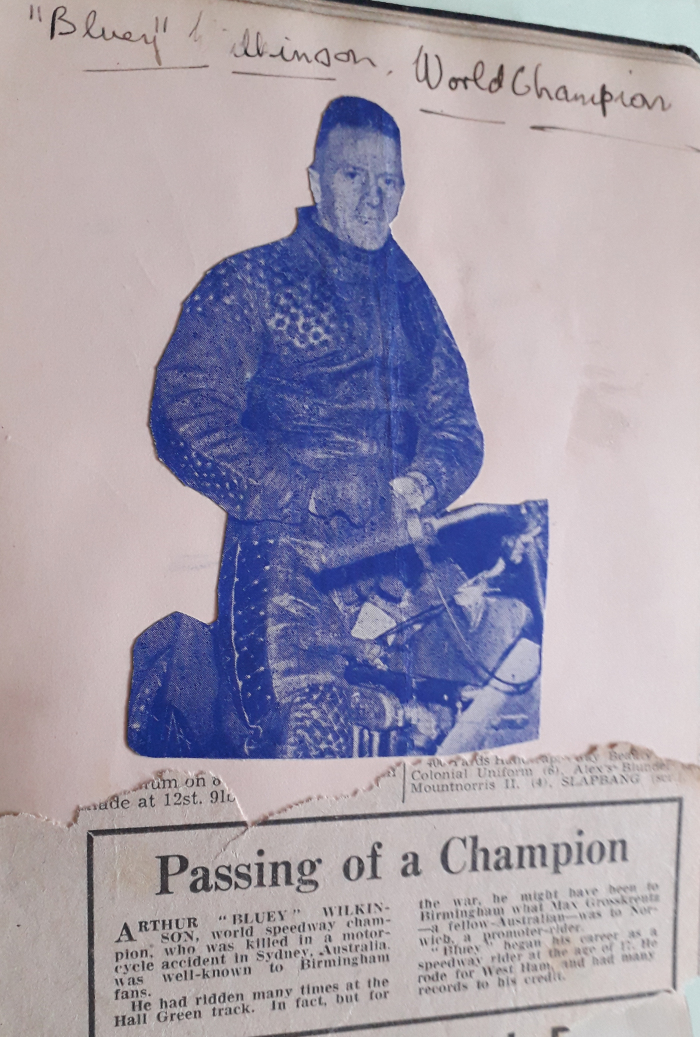 |
| |
| |
| Tiger Hart |
| |
 |
| |
| |
| Malcolm Craven |
| |
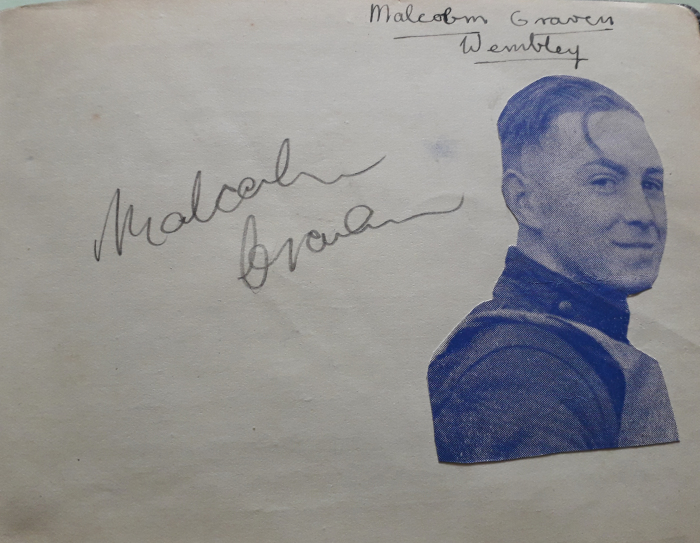 |
| |
|
| |
| |
| A Medley of Sport |
| 1931 |
| |
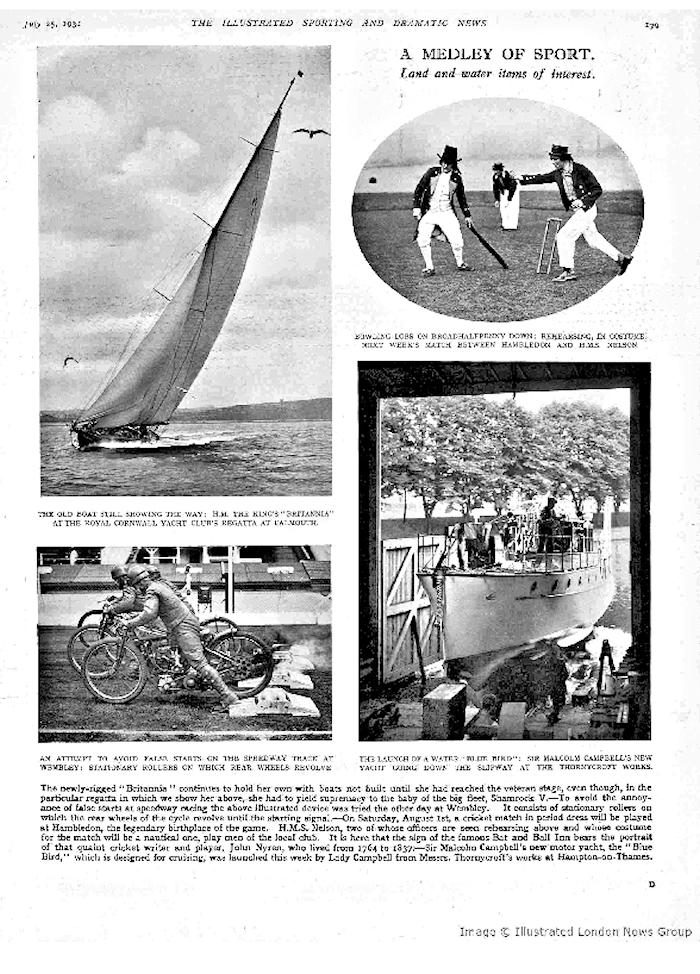 |
| Courtesy of Les Drury |
| |
| |
Dirt Track Racing
at
Crystal Palace |
| 1932 |
| |
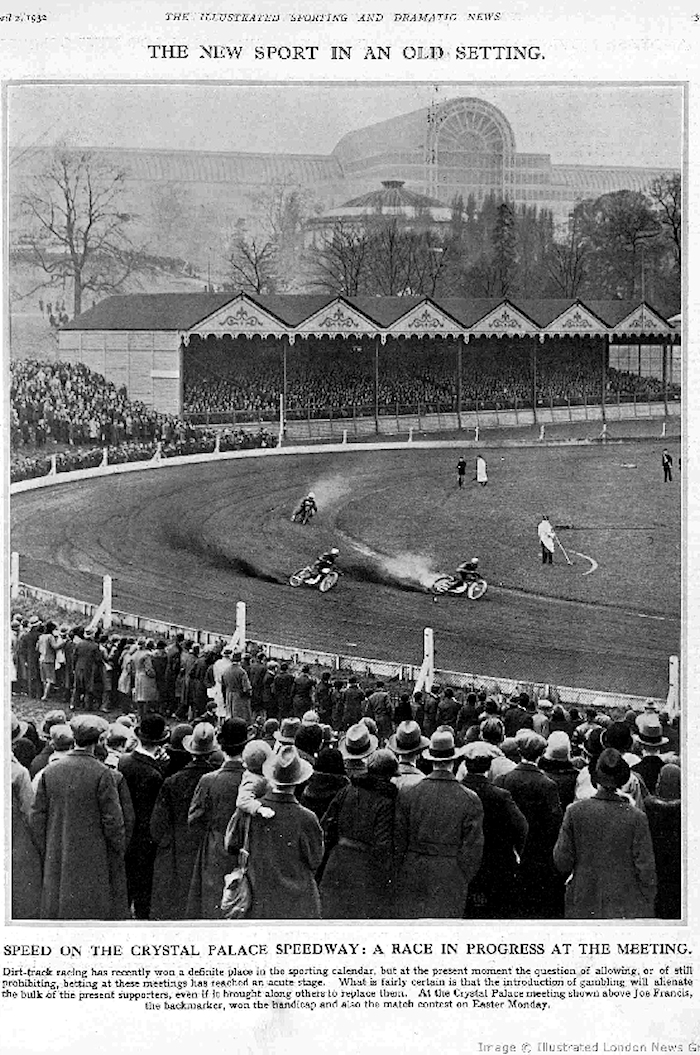 |
| Courtesy of Les Drury |
| |
| |
|
| |
| |
| Putt Mossman |
| Speedway Rider & Stuntman |
| |
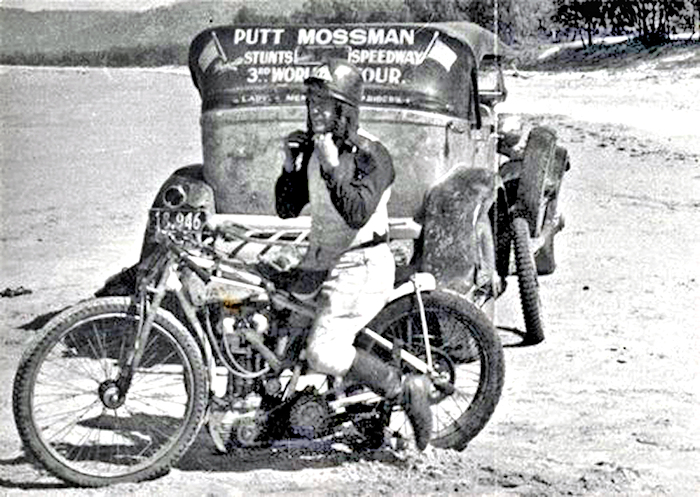 |
| Courtesy of Reg Fearman |
| |
| Born in Iowa in 1906, Orren
“Putt” Mossman is widely regarded as the most famous stunt
motorcyclist of the first half of the 20th century. Referred to as
“The Man of a Thousand Skills”, Mossman was also an accomplished
motorcycle/speedway racer as well as a professional baseball
player, wrestler, champion boxer, stuntman, Hollywood stunt
double, and horseshoe throwing national and world champion.
However, it was his motorcycling stunts that brought him
international fame. |
| |
| |
| Putt Recovering Again! |
| |
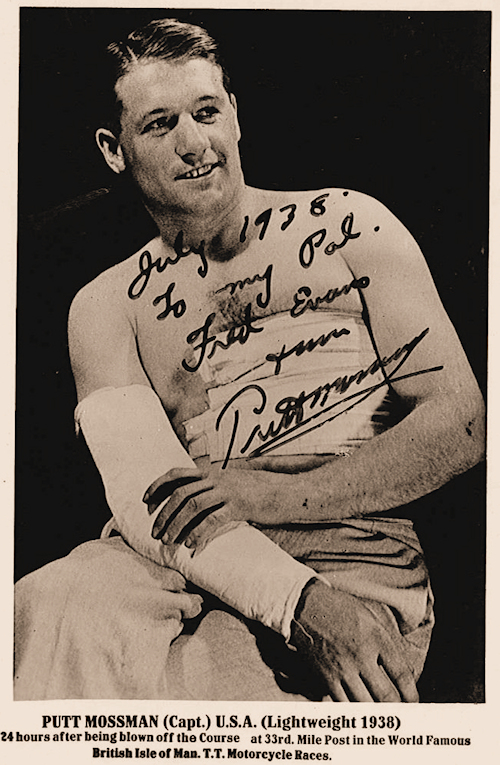 |
| |
| Putt was a regular visitor
to A&E hospitals around the world! |
| |
| |
| Putt Mossman
Speedway Rider & International
Stuntman |
| |
 |
| |
| |
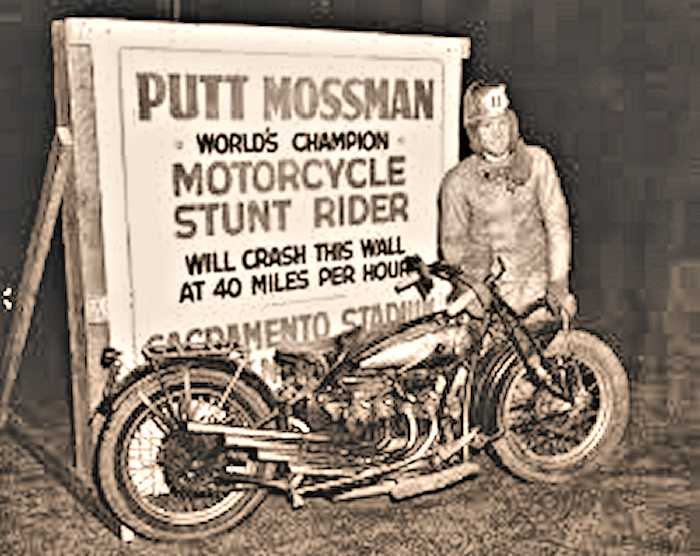 |
| |
| |
|
Putt Mossman
|
AMA INDUCTEE: 1999
|
|
Extract from the AMA Motorcycle Museum’s Hall
of Fame
World-Famous Motorcycle Stunt Pioneer
|
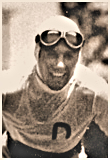 Orren
"Putt" Mossman was the most famous stunt motorcyclist of the first
half of the 20th century. Mossman and his troupe travelled America
and the world putting on spectacular extravaganzas in front of
crowds numbering from the hundreds to tens of thousands. During
his 40-year career, Mossman performed in 45 countries on six
continents. His innovative act was unequalled in his day and many
of his stunts may never be duplicated. Orren
"Putt" Mossman was the most famous stunt motorcyclist of the first
half of the 20th century. Mossman and his troupe travelled America
and the world putting on spectacular extravaganzas in front of
crowds numbering from the hundreds to tens of thousands. During
his 40-year career, Mossman performed in 45 countries on six
continents. His innovative act was unequalled in his day and many
of his stunts may never be duplicated.
Mossman was born on
July 8, 1906 in the small farming community of Eldora, Iowa. At a
young age, Mossman became popular for his horseshoe throwing
skills (something taken very seriously in that part of Iowa during
that era). Mossman quickly climbed the ranks of horseshoe throwing
and became national and world champion. (In 1967 he became a
charter member of the National Horseshoe Pitchers Association Hall
of Fame)
Mossman seemed to excel at everything he did. He
was a champion boxer, wrestler, tumbler, baseball player (he tried
out for the Boston Braves in the mid-1920s and was with the team
throughout spring training) and vaudeville performer.
When
he was 20, Mossman bought his first motorcycle. On the ride home
from the motorcycle shop, Mossman came upon two pretty young
ladies and performed his very first motorcycle stunt. He stood up
on his seat as he rode by the young ladies and nodded as he
passed. Even though Mossman would later say his performance was
rather shaky, he still received applause.
Mossman had a
longing to make a lot of money and he knew farming wasn’t the
answer, nor was horseshoe pitching. Mossman thought that he might
be able to make it big as a motorcycle stuntman. The first stunt
he did in the area surrounding his hometown was jumping over and
into rivers and he quickly made much more money than he had at any
of his other jobs.
At one of these early stunts, his
motorcycle wasn’t running well and would not have enough power to
make the jump he was set to attempt. Hundreds of people had
already paid to watch the jump. Mossman frantically went to the
nearest motorcycle dealership where he met Pee Wee Cullum. The
consummate fast talker, Mossman somehow managed to convince Cullum
to let him use his Henderson Four to make the jump. After making
the jump that night, Mossman asked Cullum to go with him to a
boxing match he was scheduled to fight in the next day hundreds of
miles away in Oklahoma. Cullum would later say that after that
first night he felt like he would follow Mossman across the world.
As it turns out, he did. It was the start of a long relationship
between the two.
Besides Cullum, Mossman’s troupe grew to
include a core group that included Mossman’s own sister, Dessie,
and later his first wife, Helen. As the shows grew, Mossman hired
temporary helpers and riders for bigger shows. He often used some
of the top Southern California Speedway riders in his shows.
The Mossman troupe was constantly on the move, performing six
and seven nights a week, primarily in high school football
stadiums. His tricks were diverse and creative. Mossman called his
show a circus and he integrated tricks he learned in vaudeville
into his performances.
Mossman was an excellent
self-promoter. In the days before television, Mossman would go to
every little town’s newspaper in the communities surrounding a
performance and get to know the editors. They all grew to love the
frenetic Mossman and he would get pages of coverage.
Some
of his tricks included: Having his sister ride sitting or standing
on his shoulders; Cullum releasing helium-filled balloons and
Mossman drawing a pistol and shooting them out of the air as he
rode; riding while juggling eggs or skipping rope; riding with a
sack over his head and using a broomstick to feel for the stadium
wall to guide him around the track; riding through plate glass or
burning wood; jumping off a ramp into a big tub of flaming water;
attaching a ladder to the rear of the motorcycle climbing up and
down the ladder as the motorcycle circulated the track. These are
just a few of the creative stunts that Mossman used to earn a
reputation for the best stuntman in America.
By the
mid-1930s, Mossman's fame had spread worldwide and he began making
appearances all across the world. He called his travelling show
"Putt Mossman and his American Motorcycle Rodeo Circus and
Speedway Aces." One performance in Yokohama, Japan drew 80,000
spectators, including the son of the emperor. Mossman visited and
performed in 45 countries in all and was considered a hero in most
of those countries and even a god in at least one.
While
riding through Uganda in a promotional ride from the top to bottom
of Africa, Mossman stopped in a small village and had to wait a
few days for supplies. In return for the villagers' hospitality,
Mossman promised the chief a performance before he departed. The
drum calls went out across the land and thousands of Africans from
villages miles away showed up to watch Mossman perform. In the
finale of the show, Mossman put a burlap sack soaked in gasoline
over his head and had his assistant ignite it. The flaming Mossman
rode his bike over a waterfall into a river below. The villagers
were in awe and honored him as some kind of mystical god.
Mossman rarely practiced his stunts and was injured numerous times
and often rode injured. Once, Mossman doused his clothes in
gasoline and Cullum was to set him ablaze, then Mossman would
start his bike and jump into a lake. The problem was after Cullum
set him on fire his Indian refused to start. Frantically Mossman
kicked and kicked and finally the bike came to life and Mossman
rode into the water. He was hospitalized for two weeks with burns
all over his body for that mistake. The injuries weren’t confined
to Mossman. Once he went off the side of a ramp and landed his
Indian motorcycle on top of his wife. She recovered after a few
weeks in the hospital. Perhaps not coincidentally, Mossman was
divorced and married at least three times.
Many say that
Mossman could have been a fine racer if he’d put his mind to it.
For fun, he raced speedway in California with some success in the
1930s and during the 1940s he raced a couple of times on the old
beach course at Daytona, running as high as fourth in the 1947
race before his bike had mechanical problems.
Mossman
fulfilled his dream of making a lot of money. He was said to have
earned and lost fortunes many times over. One thing Mossman did
for his retirement was to buy land. In a 1970s interview, Mossman
reportedly owned large tracts of land in five states.
During World War II, Mossman served in the Merchant Marine and
later worked with the USO and performed his show for troops.
After the war, television, radio and the rising popularity of
sports eroded Mossman’s drawing power. He continued to work as a
stuntman in Hollywood and continued doing his shows on a smaller
scale, often to schoolchildren and for various charities. He
continued working into his 70s. He retired to Arizona and died on
September 8, 1994. Perhaps the most daring stunt rider in
motorcycling lived to 88.
If anything describes the spirit
of Mossman, it is a quote he made in a 1935 Motorcyclist
interview. During a trip to Japan, his ship was caught in a severe
typhoon. While most other passengers lay in their cabins with
seasickness, Mossman was up on the bridge watching with delight as
the old ship stuck her nose into the massive waves. In describing
the trip in the interview Mossman said, "The humdrum monotony of
an ordinary crossing was not our lot, so we were thankful."
Inducted in 1998
|
| |
 |
| |
Speedway News
Magazine
Cover |
| 1936 |
| |
 |
| |
| |
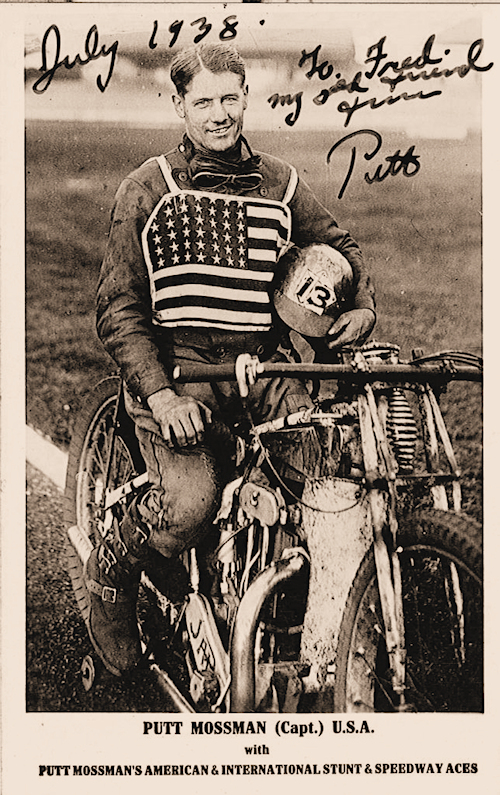 |
| |
| |
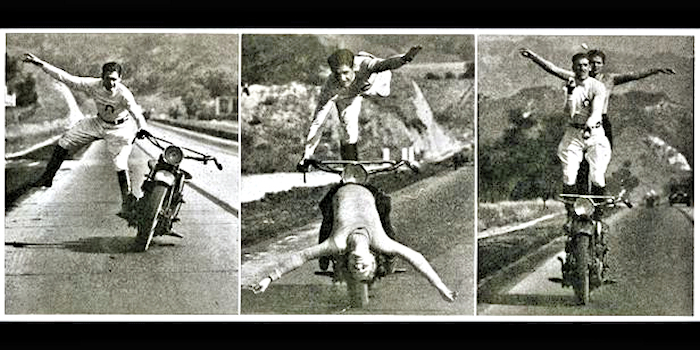 |
| |
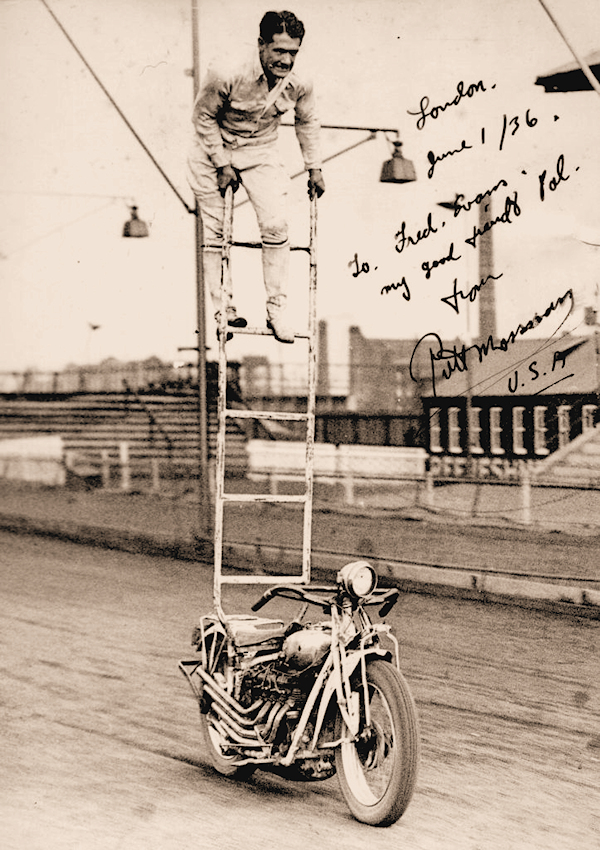 |
| |
| Looking at Putt's bike I
think it was fitted with a car engine? |
| |
| |
| Putt on The Programme |
| 1936 |
| |
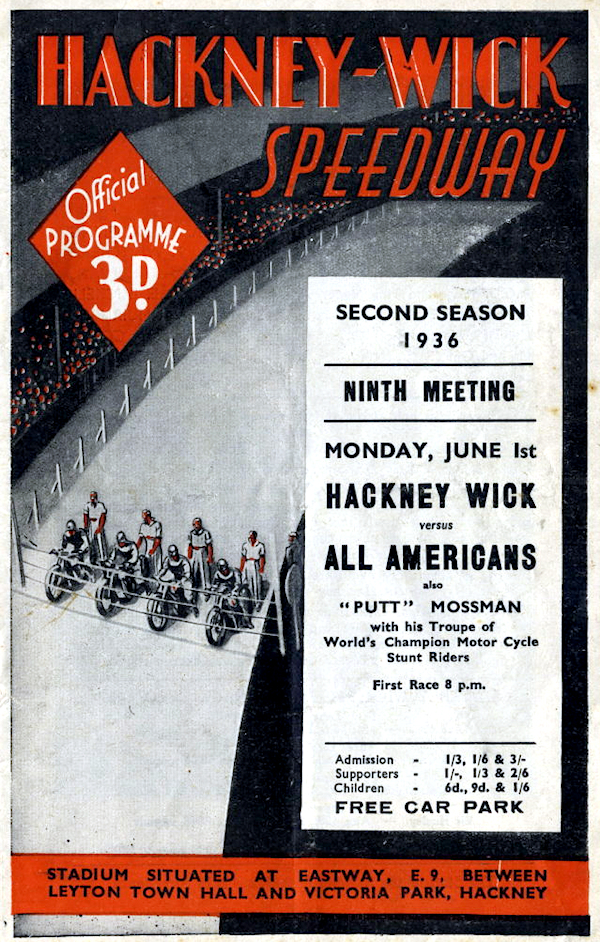 |
| Courtesy of Reg Fearman |
| |
|
Reg Fearman says: There are some interesting letters from
relatives and stories on the web about the amazing speedway
rider and stunt man Putt Mossman and Fred Evans Speedway
promoter at Hackney in the 1930s and Norwich in the 1950s -
well worth reading how an old suitcase was bought for 5
shillings in South London and contained a wealth of
information.
Note the admission prices - 15p the top price. Programme 3d
|
| |
| |
|
| |
| |
|
Victor Mucha Aviator Victoria Rider |
| |
|
VICTOR MUCHA the Russian
Daredevil
One of the most colourful characters in speedway in Victoria
during the sixties was Russian fighter pilot Vitezslav Macha born
in Moro Ostrava Russia January 26 1921. During World war two
Victor was a fighter pilot in the Soviet Airforce with the
Nornandi-Nieman squadron His name was shortened to Victor Mucha
when he arrived in Fremantle West Australia on January 17 1951 via
a German displaced persons camp at Wild Hesken which he left on
October 10 1950.
Victor took up wrestling and competed in the 1956 Olympic Games
representing Australia. Competing as a light heavyweight in the
Greco Roman style he was eliminated in the second round after two
hard bouts.
Victor then turned his attention to speedway racing at
Traceys Baxter and Brooklyn tracks. Victor was a large well built
man and he made his own frames to suit his build.
He had also taken up flying and made headlines in 1968 .
Victor acting as an instructor took Eward Lang aged 27, another
speedway rider and motor mechanic with the RAME army workshops, on
a training run. Eward originally from Baden, Baden in West
Germany Eward was on his first lesson, in a Tiger Moth.
Victor had lapsed into a coma, believed to be a reaction from a
Tetanus injection he had earlier, leaving the novice flyer to land
the plane by guess work. Eventually the frightened Ewald spotted
the Hume highway near Benalla and landed by trial and error on a
service road. All was going well until the plane hit some
earthworks and somersaulted leaving the learner pilot and the
still unconscious Victor hanging upside down from their harnesses.
The novice managed to free Victor and pull him from the wreck.
They both recovered and took up flying again!
By this time Victor had a farm near Barnawartha Victoria, where
he built an airstrip and a speedway. He started a flying school
there but he never had a pilot’s licence or an airworthy
certificate for his aircraft. Matters came to a head when Victor
crashed when landing, he quickly took the wreckage away as he knew
the crash would be reported to the aviation people. The next day
sure enough an army of inspectors appeared and Victor was in deep
trouble. An inquiry was held; meanwhile Victor had applied for a
licence. The authorities decided that due to his distinguished war
record they could not refuse him a licence which they then
granted.
The speedway was built and completed with fence's and lights
,Victor intended on starting up a school for speedway riders
when it was finished, Unfortunately Victors luck ran out, he
was killed when his Peil Emerald aircraft crashed, just before the
track was about to open. Victor was piloting local doctor Curt
Edstrom of Albury when the aircraft came down 40 k north west of
Albury on August 2 1982.Victor and Curt both died in the accident
Victor was 61, the end of a full and exciting life.
Tony Webb
2020
|
| |
| |
|
| |
| |
|
Speedway and Ice News |
| |
| I have 7 1952 Speedway and
Ice News magazines for sale. I have decided to sell them to raise
funds for paying my website hosting fees. The 7 Magazines
are shown below. Send me an email
if you wish to discuss
John |
| |






 |
| |
|
| January 2 1952 |
| |
| |
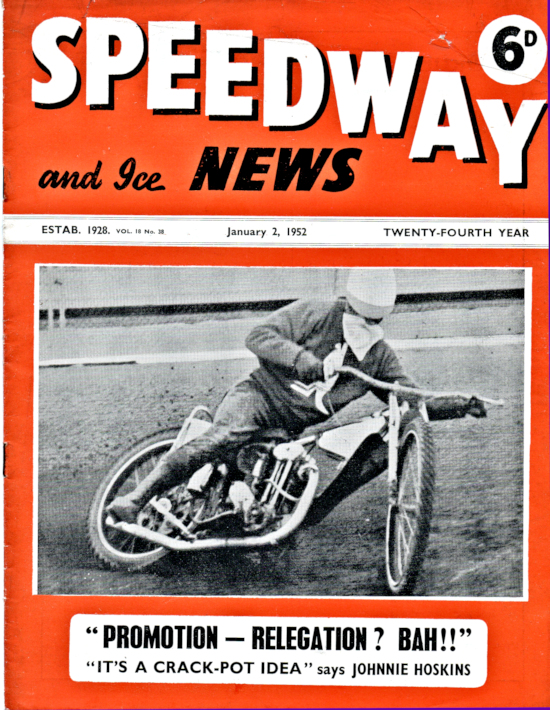 |
| Courtesy of John's Speedway
and Ice News Collection |
| |
| Norwich's Australian star Bob
Leverenz, whose bike appears to be almost in an overslide.
Or maybe it is just the camera angle. |
| |
|
| |
| |
| England v Sweden Test |
| Exeter |
| |
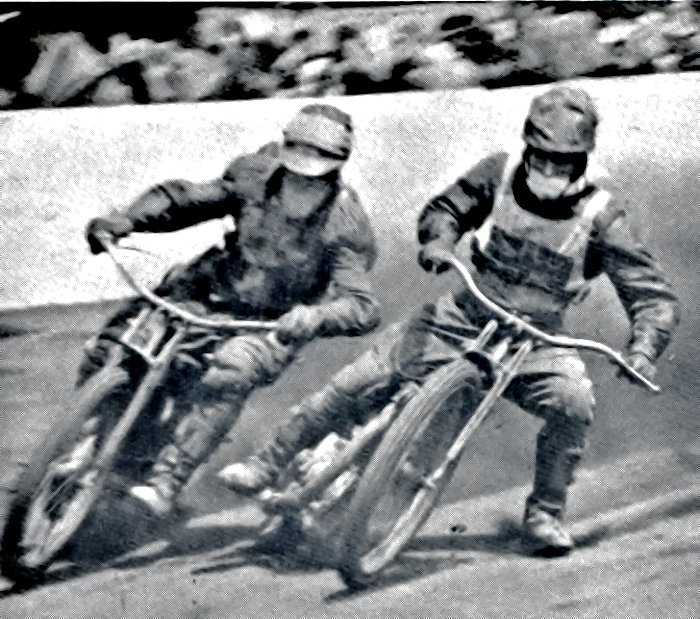 |
| Courtesy of John's Speedway
News Magazines |
| |
| Outside: Sweden's Sune
Karlsson and Inside: Englands George Wall |
| |
|
| |
| |
Coming To
Grief |
| |
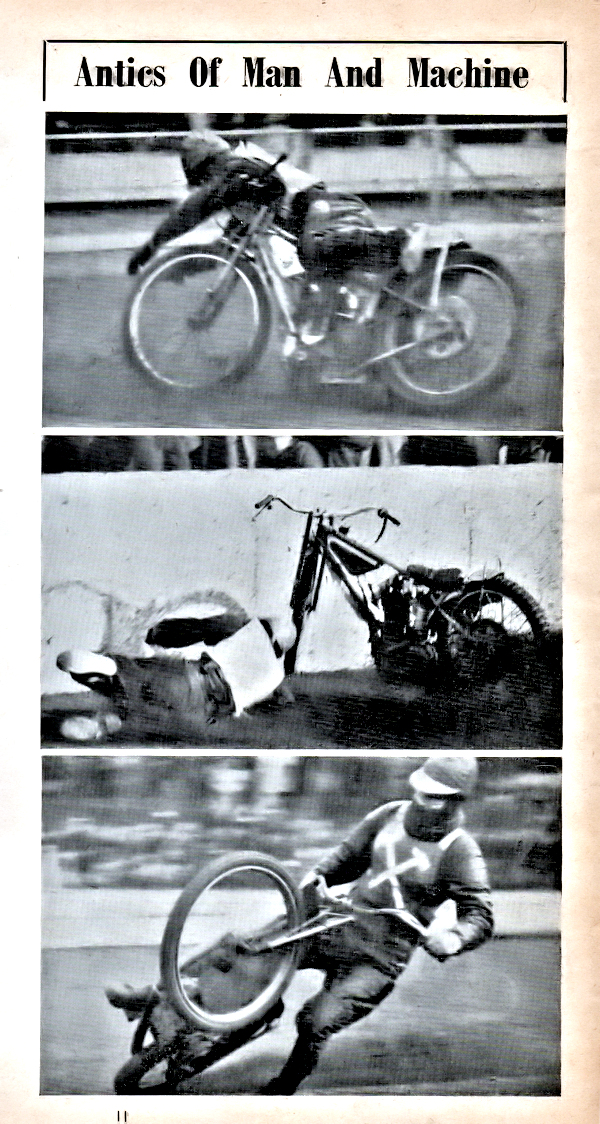 |
| Courtesy of John's Speedway
News Magazines |
| |
| Top: Harrigay's Jimmy Squibb
Middle: Bob Oakley came to grief to avoid the already fallen
Freddie Williams. The Bottom pic: is Mr Speedway Reg Fearman
about to test the padding his leathers have in the sitting down
area. |
| |
|
| |
| |
| January 9 1952 |
| |
 |
| Courtesy of John's Speedway
News Magazines |
| |
| In front Oxfords Harry
Saunders, Ken Walsh (Exeter) and Cheetah Eric Irons |
| |
| |
| England v Australia 1951 |
| |
 |
| Courtesy of John's Speedway
News Magazines |
| |
|
| |
| |
| February 6 1952 |
| |
 |
| Courtesy of John's Speedway
News Magazines |
| |
| Exeter's Bob Roger is
presented with a badge his team mate Don hardy is struggling to
keep his attention on the ceremony |
| |
| |
Name The
Riders |
| |
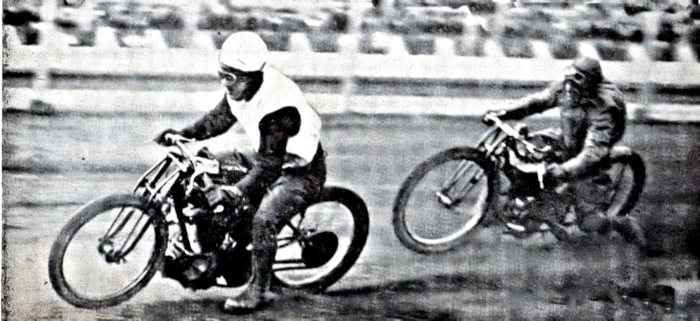 |
| Courtesy of John's Speedway
News Magazines |
| |
| The picture appeared in the
Speedway and Ice News as a "name the riders" feature. I
believe it would have been taken around 1932, so go on then name
the riders! John
The mag is only 65 years old so perhaps they will still send you a
prize! |
| |
|
| |
| |
| February 13 1952 |
| |
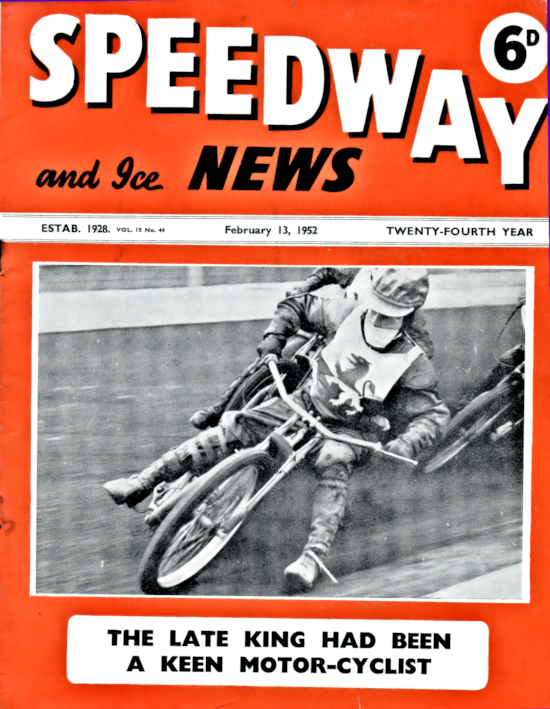 |
| Courtesy of John's Speedway
News Magazines |
| |
| |
| |
| King George V1 Had a Douglas |
| |
 |
| Courtesy of John's Speedway
News Magazines |
| |
| |
| Jack Parker |
| |
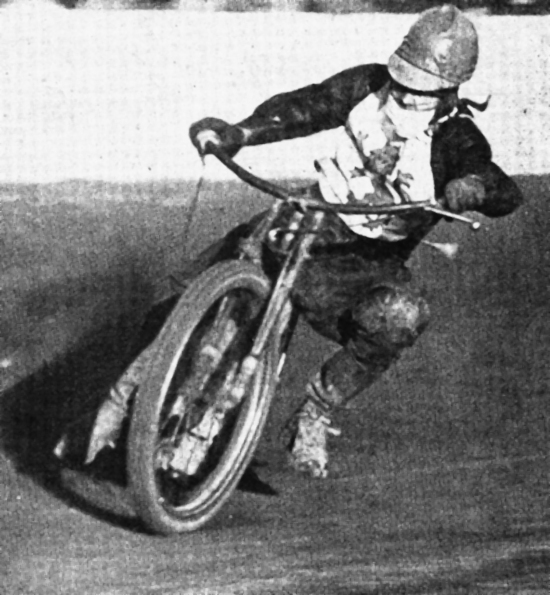 |
| Courtesy of John's Speedway
News Magazines |
| |
| |
| Wally Green |
| |
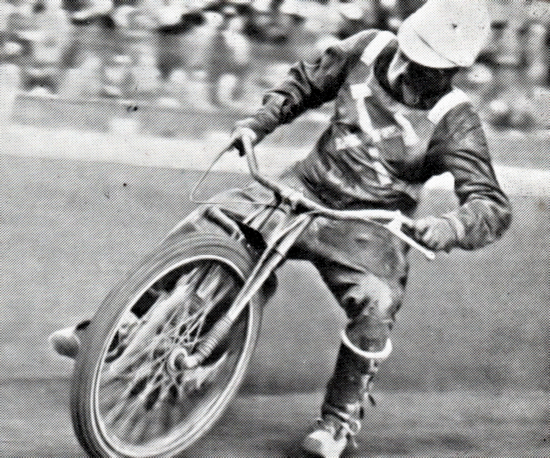 |
| Courtesy of John's Speedway
News Magazines |
| |
|
| |
| |
| February 20 1952 |
| |
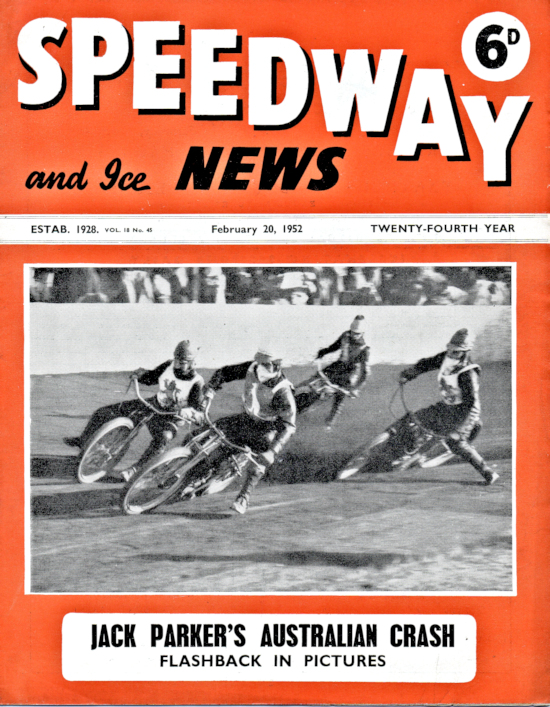 |
| Courtesy of John's Speedway
News Magazines |
| |
| Cover picture: Bradford 1951
The riders are Cyril Roger, New Cross Bob Leverenz (Norwich)
Jack Biggs of Harringay and Belle Vue's Jack Parker with the
strange angle his leg is at! Jack went on to win the race
for England with his England team mate Cyril Roger second and
Aussie Jack Biggs in third. England won the match 59-49 |
| |
| |
| Syd Jackson |
| |
| |
 |
| Courtesy of John's Speedway
News Magazines |
| |
| 1933 Syd was very photogenic
never acheived very much and called it a day 2 years after this
photo was taken. |
| |
|
| |
| |
| March 5 1952 |
| |
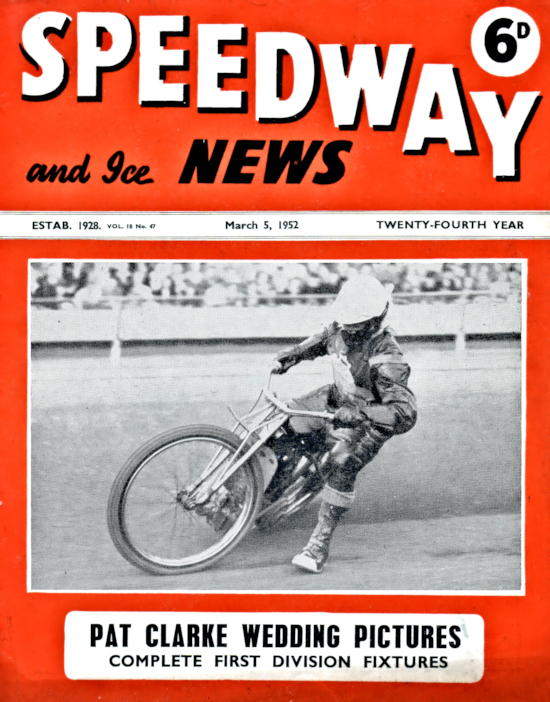 |
| Courtesy of John's Speedway
News Magazines |
| |
|
| |
| |
| March 19 1952 |
| |
 |
| Courtesy of John's Speedway
News Magazines |
| |
| |
| Entertainment Tax |
| |
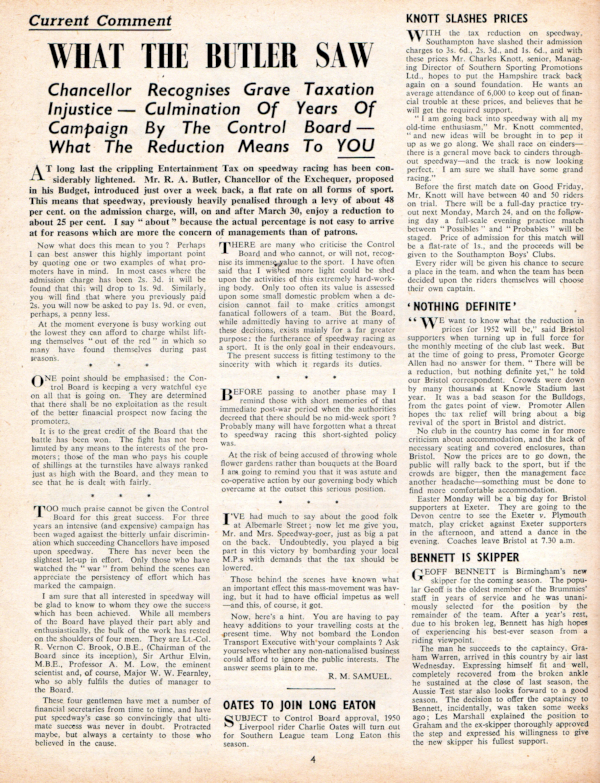 |
| Courtesy of John's Speedway
News Magazines |
| |
| So there they are 7 issues of
Speedway and Ice News from 1952, 65 years ago. The mags are
in excellent condition and if you want to buy/discuss them send me
an email John |
| |
|
| |
| |
| Speedway and Ice News |
| |
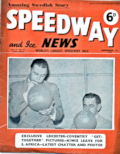
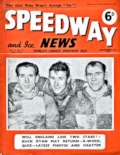
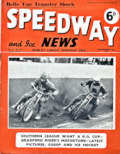
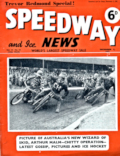
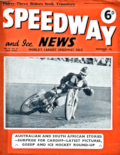 |
| |
| |
| I found another 5 1952
magazines which I would be happy to sell, so if you want them,
please send me an email
John The mags are as follows: - |
| |
| November 12 1952 |
| |
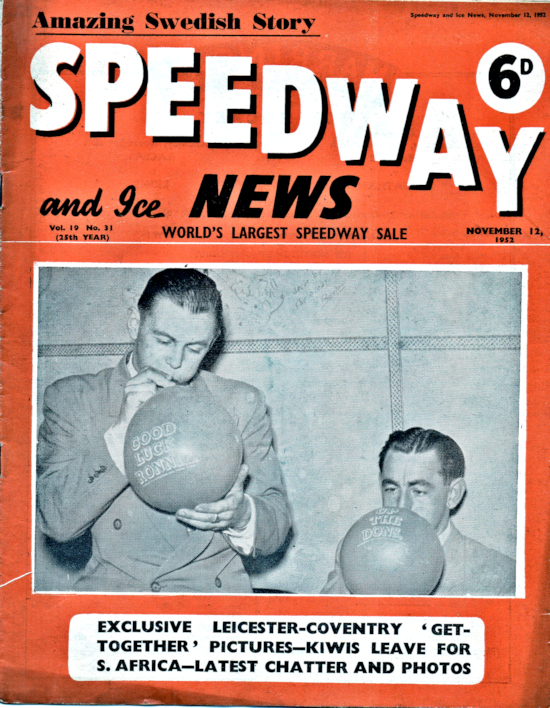 |
| Courtesy of John's Speedway
News Magazines |
| |
|
| |
| |
| November 19 1952 |
| |
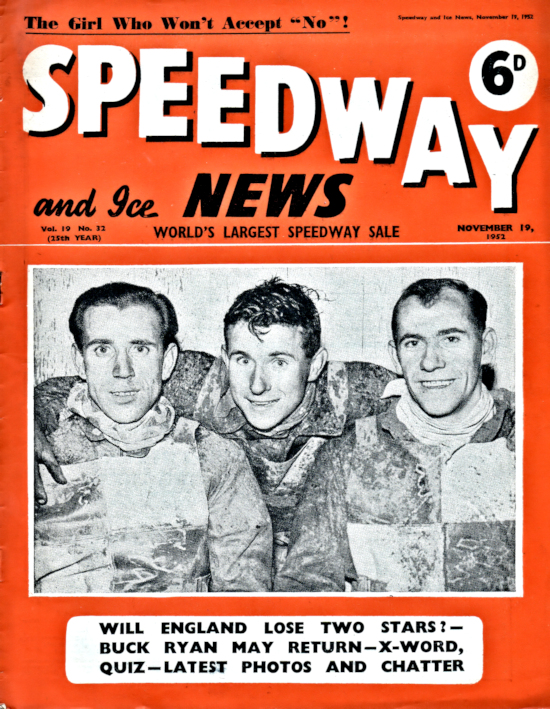 |
| Courtesy of John's Speedway
News Magazines |
| |
| Ipswich riders feature on the
front cover of this issue. Charlie Mugford, Tich Read and
Sid Clark. |
| |
|
| |
| |
| November 26 1952 |
| |
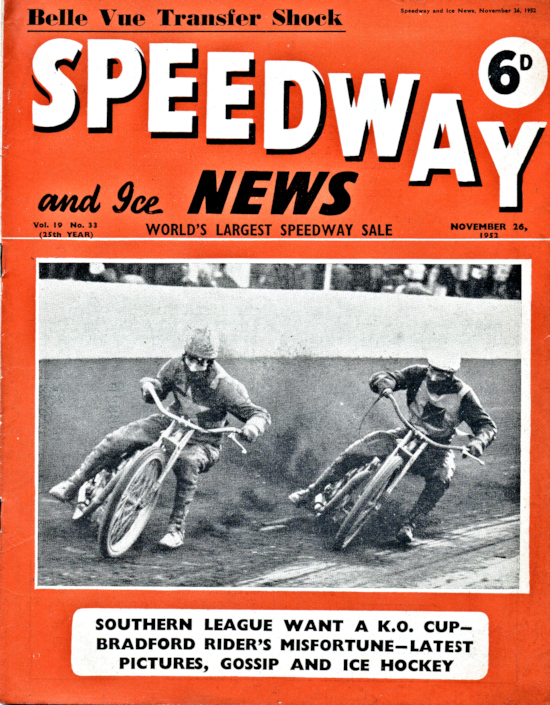 |
| Courtesy of John's Speedway
News Magazines |
| |
| |
| Wall of Death |
| |
| This curious snippet appeared
in the magazine: - |
| |
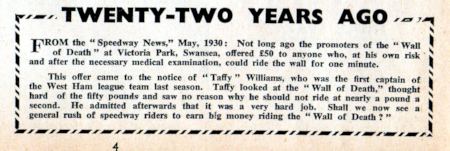 |
| Courtesy of John's Speedway
News Magazines |
| |
| A 1930s challenge like the
above would now be prohibited in the UK and any insurance
cover would be extremely expensive. However a good few
speedway riders moonlighted as wall riders to earn a few more
quid! There is a decent sized
section about speedway riders on the wall on this website.
Go to Miscellaneous page 5 if you are interested. |
| |
|
| |
| |
| December 3 1952 |
| |
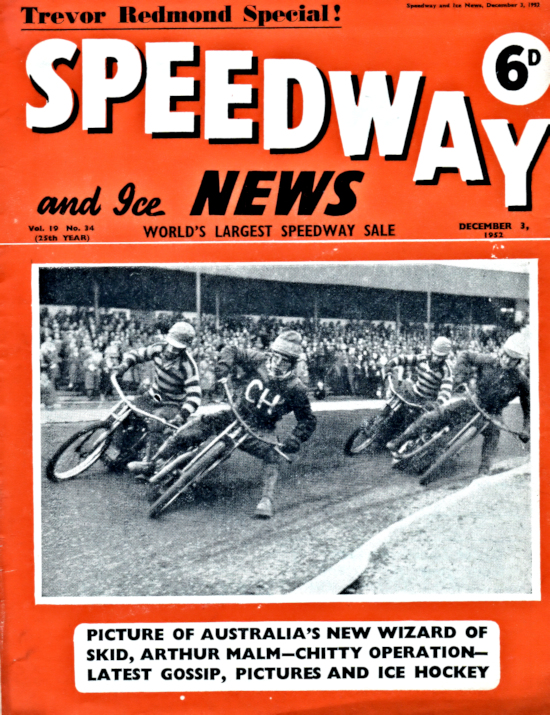 |
| Courtesy of John's Speedway
News Magazines |
| |
| Coventry v Cradley Heath.
Left
to right Johnny Reason, Geoff Bennett, Stan Williams and Brian
Shepherd |
| |
|
| |
| |
| December 10 1952 |
| |
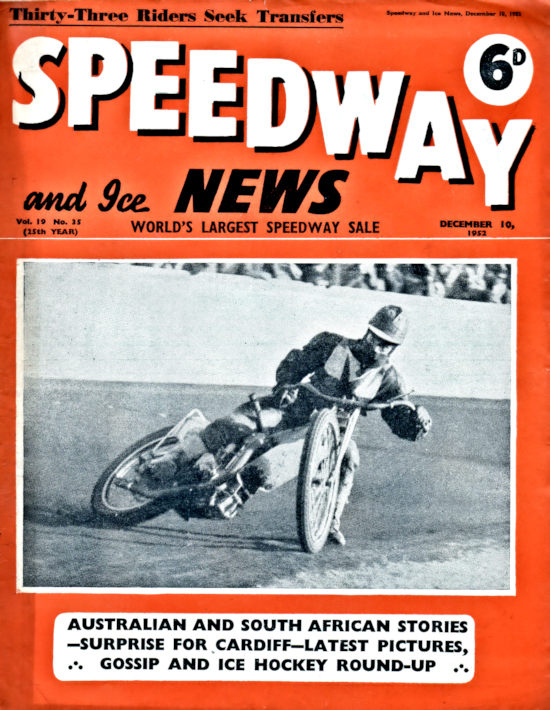 |
| Courtesy of John's Speedway
News Magazines |
| |
| So that is it another 5 mags,
shown above. I will leave the scans on the website as they
are an interesting addition. Anyone interested in bidding
for the mags could send me an email
John |
| |
| |
|
| |
| |
Homburg Saar, Germany
In The Late
1950s
|
| |
 |
| Courtesy John Hyam |
| |
| John Hyam says: This is a cartoonists
view of speedway as used by the German promoters at Homburg Saar
to promote their 1958 international meeting featuring Germany,
Austria, Holland and England. |
| |
| A great work of art. I particularly like
the speed blurs and how the two riders blend into one. |
| |
| |
|
| |
| |
|
Pre-War Helmet Colours |
| |
| In modern times we have Red and Blue for
Home Riders with White/Green and Yellow/Yellow& Black Away Riders.
This wasn't always the case. |
| |
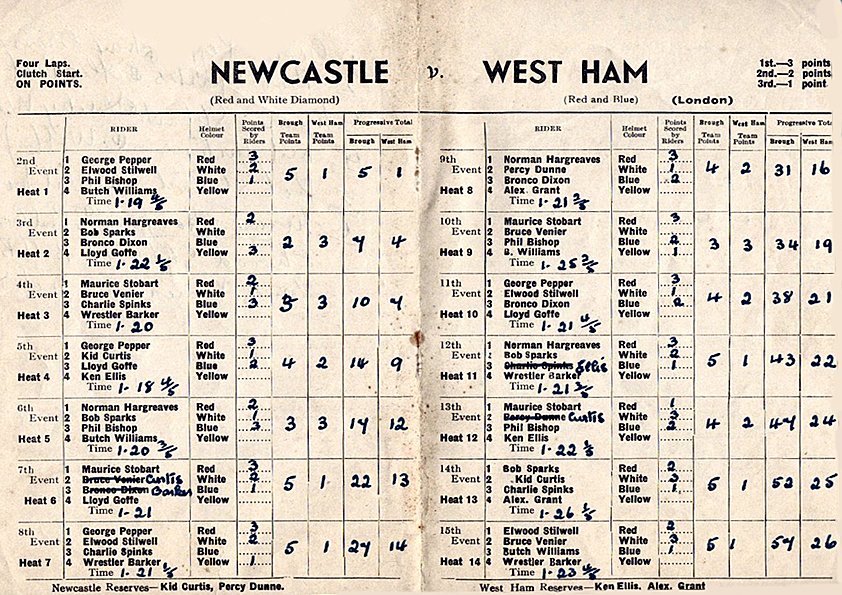 |
| |
| This pre war 1938 programme of a
Newcastle v West Ham match. It shows the team colours
Newcastle: Red and White and West Ham: Red and Blue.
You may not have expected the Newcastle body colours to be shown
as Red and White, as in modern times, from 1961, Newcastle have
always been Black and White! |
| |
| Stranger still, the helmet colours are
Newcastle Red and White and the visitors Blue and Yellow! So
is this a printing mistake or were the helmet colours right?
If you can throw any light on the helmet colours please email me
John |
| |
| Newcastle fans will be pleased to see
that we hammered the hammers 57-26 with the Diamonds hero George
Pepper scoring a 12 point maximum |
| |
| |
|
| |
| |
| Birmingham Team
1929 |
| |
 |
| |
| Six riders all mounted on Douglas machines so
this could be as early as 1928 or possibly 1929. I don't know any of the
riders or the venue, can you help
John |
|
Terry Stone says: No 14 is Jim Kempster |
|
Valerie Davey says: The track is Stamford Bridge |
Nigel
Bird says: Six riders mounted on Douglases; Venue :
Stamford Bridge , This is the 1929 Birmingham Perry Barr team, rider on the left
is Wally Lloyd, I would be very surprised if Jim Kempster is among these riders,
I only wish I could positively identify the others. The numbers on the bikes can
be a bit unreliable as a form of identification.
Valerie Davey would
recognise this track, as her Grandfather raced here. |
| |
| |
|
| |
| |
1953
Australian
Test Team
At Norwich |
| |
 |
| Courtesy of Ashley York |
| |
| Ashley York says: This
photo was with the photo of the Norwich rider (shown
above). The team photo looks like it may be of a
touring Australian Test team – perhaps they raced at
Norwich. This is all pure speculation on my part
based on what I have found on the internet – I have no
knowledge of speedway myself. I would be interested
though If you are in a position to provide any
information about the photos, such as when they might
have been taken, whether it is an Australian Test
team, and who any of the individuals are. |
| Colin Greenwell says: The
"Australian team" is from L-R standing: Arthur Payne,
Keith Gurtner, Athur Simcock, Jack Young, Aub Lawson and
kneeling: Johnny Chamberlain, Ronnie Moore, Peter Moore
and Jack Biggs |
| Steve
Brown says: The pic of the Australian team you just posted
was indeed taken at Norwich. It was from the first
England v Australia Test on June 20, 1953, and was won by
the visitors 62-46. Back : Arthur Payne, Keith Gurtner,
Jack Young, Aub Lawson. Front : John Chamberlain, Ronnie
Moore, Peter Moore, Jack Biggs. Ronnie Moore scored an
18-point maximum. |
| Don Price says: Just spotted the
Australian team photo in your " name the rider" section so
I'll have a stab at this. I think the riders are... (back
row) Arthur Payne, Keith Gurtner, Jack Young, Aub
Lawson.. (front row) John Chamberlain, Ronnie Moore,
Peter Moore & Jack Biggs,. 1st Test @ Norwich 20th of
June 1953. Australia won 62-46. All the best, Don. |
| |
| |
|
| |
| |
|
Concrete/Tarmac Starting Areas |
| |
| In the modern era we are all used to see
our riders digging in the dirt at the starting area before
settling down for the tapes up. This wasn't always the case
as once upon a time the starting area was either concrete or
tarmac |
| |
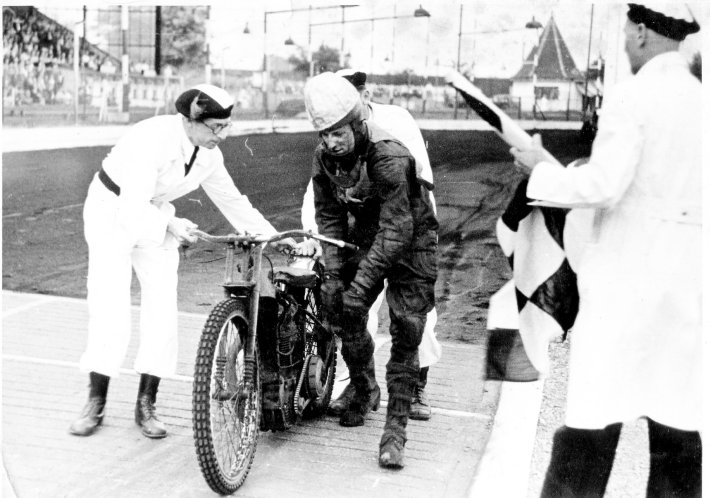 |
| Courtesy of Jim Henry |
| |
| This photo of Walthamstow
shows a concrete starting grid. God knows what was going on
here! But the rider couldn't have been digging the dirt with his
boots as it was solid concrete! |
| |
 |
| Courtesy of Colin Greenwell |
| |
| This is 1940s Cleveland
Park Middlesbrough. A Tarmac starting grid and their
rider Frank Hodgson appears to
be restricted to a rather narrow grid 1? |
| |
| |
| The Starting Gate Rule |
| |
 |
| |
| So what could be better? A
consistent start area without advantage. I wonder why it
didn't catch on and now we have starts on the dirt with multiple
winners from one starting position and none from another. Is
it time to get the boys from the black stuff in to tarmac our
starts again? |
|
I am not old enough to have watched
racing when these starting areas were in use. If you witnessed
speedway with these grids please send me your comments
John |
| |
| |
| A Concrete Start |
| |
 |
| Picture courtesy of Fred Pallett |
| |
| John says: The small text reads:
Starting Hazards, Oliver Hart and Split Waterman find their
front wheels lifting on the concrete starting area. Neither
turned over but Hart's machine broke the bottom tape of the
rising gate causing a restart. Concrete in place of the softer
tarmac was a 1950 change which upset several riders including
Waterman and Vic Duggan - G.R.A. photo taken at Harringay |
| |
| Fred Pallett says: Hello John, I am
not too young to remember this! I remember that all the London
tracks had a hard starting area of some kind. I always assumed
them to be concrete, but some could have been
tarmacadam/asphalt. I clearly recall that, at Wembley Stadium,
the driver of the tractor that towed the grader between heats
used to raise the grader off the ground when passing over the
starting area. Stenner’s 1951 Speedway Annual (World Edition)
includes a centre pages (48/49) photograph spread, taken at
Harringay, showing Oliver Hart (Odsal) and Split Waterman
(Harringay) with their front wheels lifting “on the concrete
starting area” – see attached scan (above). The caption goes
on to state that “Concrete in place of the softer tarmac was a
1950 change which upset several riders, including Waterman and
Vic Duggan”. As a Wembley supporter, my speedway attendances
ceased in June 1954, so I am unable to confirm the situation
in later years. Many cycle speedway tracks also had hard
starting areas, as they were generally modelled on motorcycle
speedway tracks. |
| |
| |
| Stoke's Starting Grid Area |
| |
 |
| Picture courtesy of Reg Fearman |
| |
| John says: 8 Belle Vue riders on the
concrete at Stoke. I suppose a trackman that could grade
dirt up to a seemless join with concrete would be ok and trackmen
that couldn't would have a bump as the bikes entered the concrete
section. Not good eh? |
| |
| Reg
Fearman says: John, The concrete starting gate came into
Regulations just after WW II. All tracks had to install the
concrete slabs which were made by the one contractor and
indeed were all the same size and length. They did have
'grooves' which can be clearly seen in the first photo. My
attached photo shows clearly the Starting Area at Stoke
Speedway in 1953. The idea of course was to 'Standardise' the
starts. Later came complaints about the 'bump' at high speed
when the race was on, it could be very noticeable between the
track and concrete.. They were then all torn up and reverted
to the old fashioned dirt start then much later followed the
time wasting 'gardening'. Cheers, Reg |
| |
|
John Chaplin says: John,
For a start (no pun intended), I resent the
implication that I am 'too young' to remember concrete
and tarmac starting areas.
{ John Skinner says: oops sorry didn't think you would
be so touchy!}
I saw them up until 1956. I have always advocated
a return to either them or the technique used when
they were in use. Riders would come up to the two
yard line (about the length of a bike back from
the tapes) where they would be stopped by the
starting marshall. When the Steward (referee) put
the green light on the riders were allowed to move
up to the tapes. they were then 'Under Starters
orders'. They remained still until the tapes went
up. As I recall there was no tape pushing and
there was certainly no point in 'gardening' at the
gate. However, if a rider miscalculated and
looped, it hurt to fall on the hard surface. Few
did.
Regards, John Chaplin
|
| |
| |
New Cross Concrete
Starting
Area |
| |
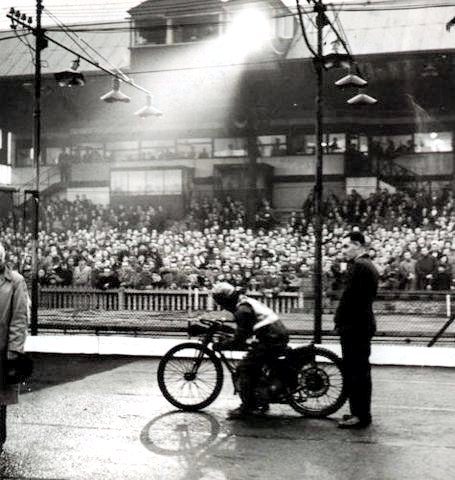 |
| |
| John says: Ron Johnson on concrete at New Cross in 1946
curiously it shows the concrete extending well before the
starting gate, why was that? and as the track appears to be wet I wonder that
if the concrete wasn't laid properly that puddles would appear on wet
nights? |
| |
| If you have any photos or views on
starting areas please email me
John |
| |
| |
|
| |
| |
| Lenningrad
USSR |
| |
| |
| |
 |
| |
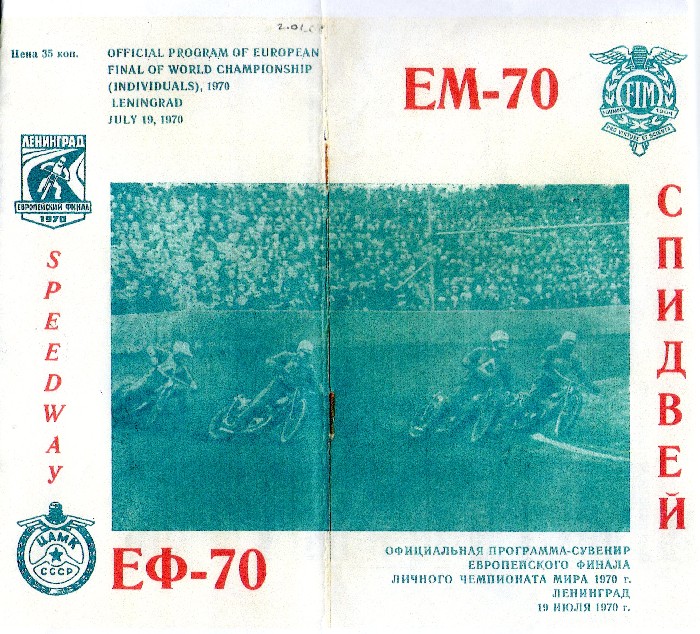 |
| Courtesy of Graham Gleave |
| |
| |
|
| |
| |
| Bob & Gil |
| |
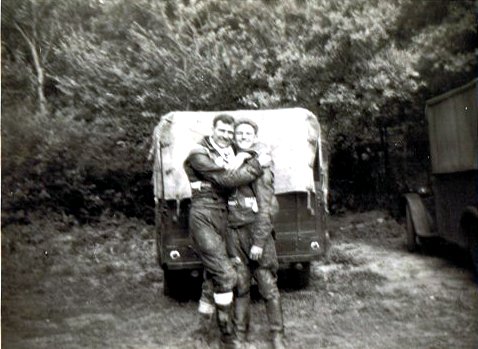 |
| |
| Bob Andrews sent the above photo, he says: Here is a photo
of Gil Goldfinch and myself taken in 1954 at Eastbourne. I had
just won the Silver Helmet Championship there. He was giving
me “a man hug” in the pits, my ex. Army van is behind us. An
Austin. |
| |
|
|
|
| |
| |
Old Bike Makes
Prior To UK Speedway Starting
In
1928 |
| |
| As a biker as well as a speedway fan I am interested in the makes of bikes used on Dirt Tracks
prior to racing commencing in 1928 in the UK. I asked Aussie
Tony Webb for info on bikes in use when Dirt Track racing was Australia's
private property. Tony sent me a scan from a 1926 Sydney,
Australia programme. |
| |
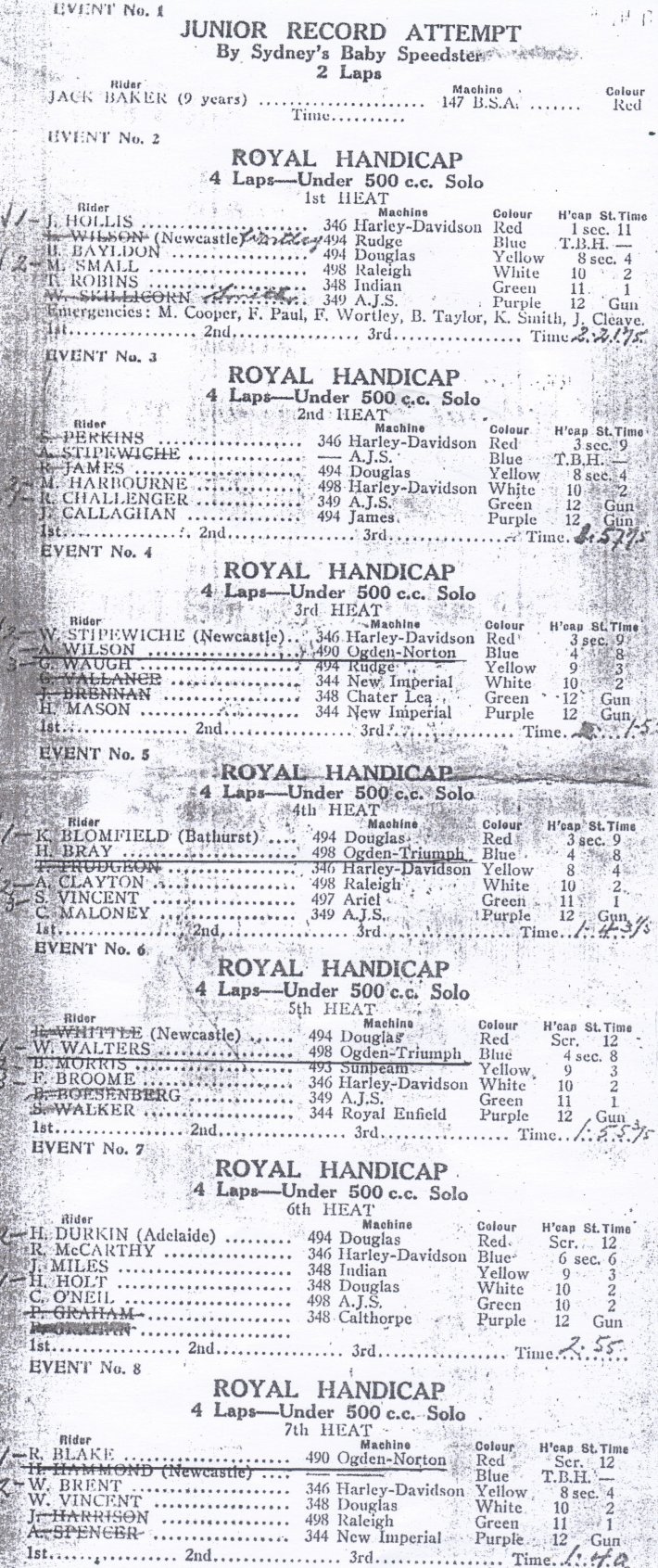 |
| |
| The 1926 Australian programme shows the bikes each rider was
using. Glancing through the list of machines the vast
majority of bikes were British with a couple of American machines
Harley-Davidson and Indian added in! Douglas and Rudge are listed
too. The two British bikes went on to dominate a couple of
years later. I notice two machines Ogden Triumph and Ogden
Norton. I presume Ogden added some improvements to the
standard Triumph and Norton. I also note James and Royal
Enfield. Which were makes I enjoyed owning in the 1960s. My
James and Royal Enfield bikes were road going machines though. |
| |
| My understanding of the top1920s dirt track machines was that
Harley Davidson was the first winning machine, with AJS also
having some success. Followed by the very successful Douglas and
the Rudge, then in 1931 the British made JAP came along and swept
all the earlier opposition away. |
| |
| |
|
| |
| |
Obituary
Bob Sharp |
| |
|
VSRA News desk
13 September
2012 |
|
Very sad news from Tara, Queensland, Bob "Cowboy"
Sharp, former
Australian Champion has died following a heart attack at on September
12 2012. Bob is well remembered in Great Britain for his time at White City
Glasgow and Ipswich 1952-1958. |
|
According to Bob’s son, Ron Sharp, his dad had visited the local
hospital regarding a knee replacement. He suffered a heart attack at a
friend’s house later. |
|
It is understood that Bob has a burial plot in his home town of
Tara which is . approx 300 k west of Brisbane VSRA Editor
|
| |
| |
|
| |
| |
Eastern
Speedways, Norwich on Sunday
Independent & Journal
10th
September 1932
|
| |
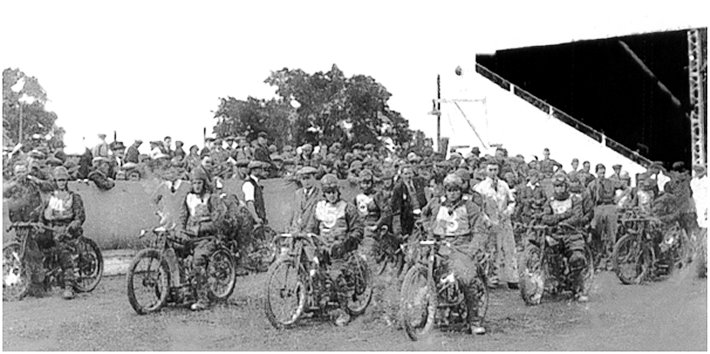 |
| A great picture from Speedway Researcher Jim Henry. |
| |
| Competitors line up for the start of the
grand parade of the riders at the Eastern Speedways, Norwich on
Sunday
Independent & Journal 10th
September 1932)
On
the front row are Number 3 Jack Smythe and 5 Geoff Pymar |
| |
| |
| Another Great Picture From Jim Henry |
| |
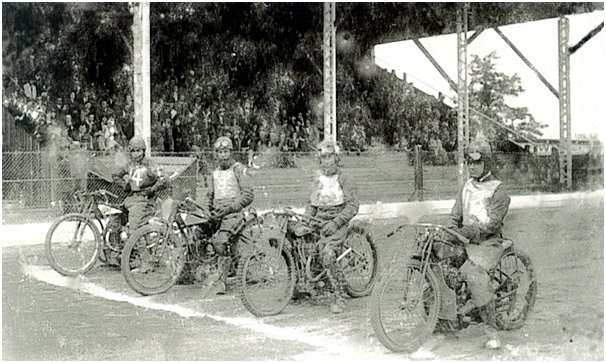 |
| |
| Another Picture from Jim Henry Speedway Resarcher.
Jim says: Final of the Big Twelve.
14 - Hal Herbert, 8 – Fred Wilkinson, 2 – Wally Banner, 12 Arthur
Johnson. Result - - - - - First Wilkinson 87.1/5
seconds, second Banner, third Herbert |
|
Riders who took part in this
meeting taken from the program are
1-Arthur Reynolds, 2-Wally
Banner, 3-Jack Smythe, 4-Reg Stanley, 5-Geoff Pymar, 6-Jack Allby,
7-Wal Smith,
8-Fred Wilkinson, 9-Jim
Milward, 10-Don Dimes, 11-Don Boswell. 12-Arthur Johnson, 14-Hal
Herbert, 15-S. Gardner,
|
|
16-W. Phillips, 17-C. S.
Gill. 18-Johnnie Glass, 19-Jack Eldon.
It was reported in the press that Fred
Wilkinson won five out of his seven races, but the filled in
programme gives him four wins and three seconds. Without doubt
Fred was the top rider in this meeting and from the programme he
would have won £8.10.0 (£8.50) in prize money. This was not a bad
payday as in the programme a Hercules bicycle was advertised at
£3.19.0. A Two Seater Morris Minor Car at £100 and a 250c.c. Rudge
Motor bike cost £38. The admission was 7d & 1/-. As there were 20
1/- to a £, it would equal to 170 fans paying 1/- for Fred’s
winnings that day.
|
| |
| |
|
| |
| |
|
Jack Sharp In
Singapore |
| |
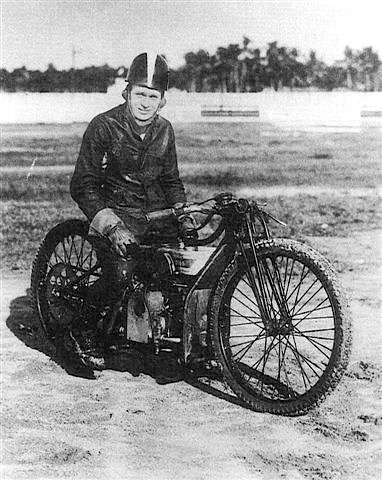 |
| |
|
Before
Australian Champion
Jack
Sharp
arrived
in England in 1931 he rode a season in Singapore and left winning
a Silver Gauntlet and holding the track record. If
anyone has info regarding racing in Singapore please email me
John |
| |
| |
|
Advert For Singapore Meeting
|
| |
 |
| |
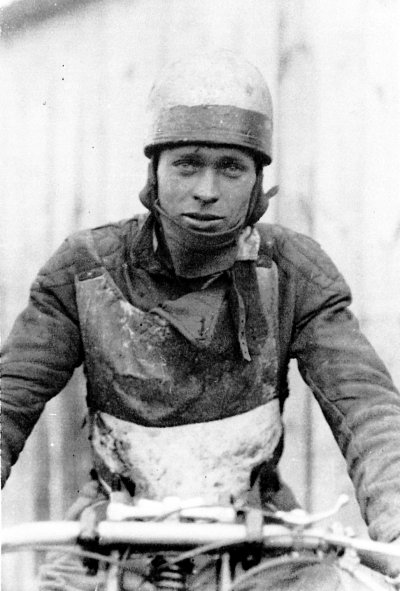 |
| |
| |
|
| |
| |
John (Jack) &
Frank Chiswell |
| |
 |
| |
| A truly great example of a 1929/1930
'ish photo which would have been black and white, hand tinted with
colour. The photo was sent to me by Mike Darby who is the
nephew of the two brothers shown above. They are John and
Frank Chiswell from Loughton Essex. The bike is a Douglas
which had its day around that time. |
| |
Mike
Darby says: Dear John, My late Uncle John Chiswell was an early
dirt track rider and with his brother Frank rode at High Beech, as
they came from Loughton Essex where the family ran a garage, and I
believe Belle Vue, Manchester.
My uncle was born 1908 and married my
fathers sister Constance Darby, who was pioneer ladies biker in
her day.
Uncle John died in 2001 aged 93 and although he showed me these
photographs he never really told the full story of their dirt
track days.
The cartoon was I believe published in a
magazine of the time, 1920/30’s, but I know very little else.
Have you heard of the Chiswell Brothers?
Kind regards
Mike Darby |
| |
|
John says: Can anyone supply
any more info on the Chiswell's ? email me
John |
| |
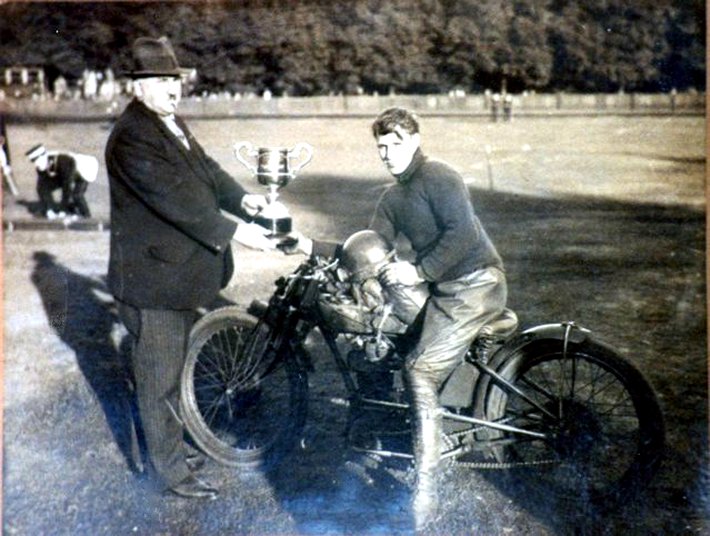 |
| |
|
Not sure which of the brothers this
one is. The bike is a bit strange to me so if you can
identify it send me and email
John The
strengthening strut along the frame may be a clue. |
| |
| Nigel Bird says: Sorry can't name which
Chiswell brother it is but the machine is an AJS road bike
converted for speedway, Track High Beech1928 |
| |
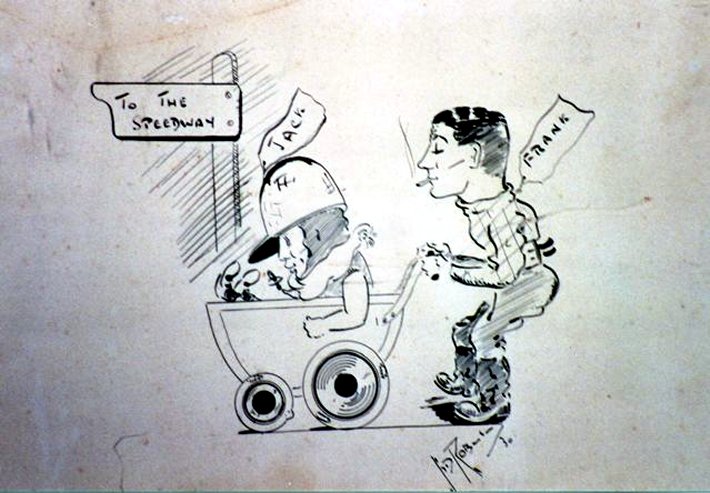 |
| |
| John may have used the name Jack as in
this sketch. Mike and I would love to hear from anyone whom
can supply any info on the Chiswell brothers. |
| |
 |
| |
| John or Frank Chiswell could
be at High Beech? Great pictures Mike: if you
find anymore send them in please |
| |
| |
|
| |
| |
| Speedway Cricket
Match |
| |
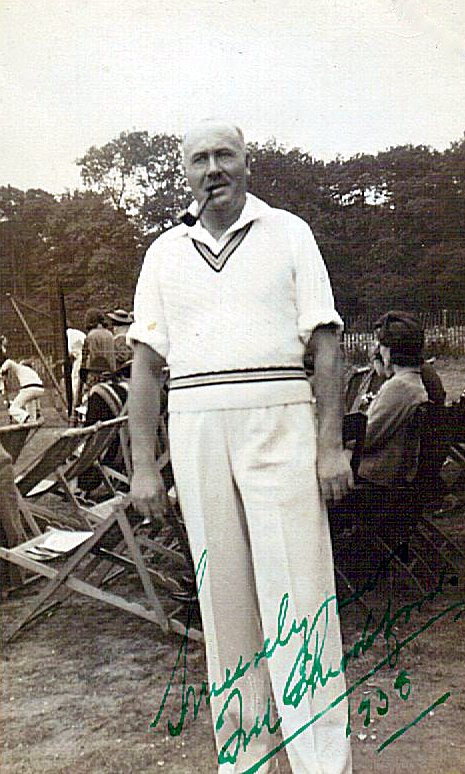 |
| |
|
From formbyfalls:1938
Fred Mountford
Fred Pallett says: Hello John, May I offer the following
small correction to Miscellaneous Part 4. Under the
heading of “Speedway Cricket Match”, there is a photo of a
man in cricket whites with the caption “Fred Mountford”.
This should read Fred Mockford, who was the
promoter of Crystal Palace Speedway in the 1930s, before
moving his operation to New Cross, where he was still the
promoter after World War 2
|
| |
| |
|
| |
| |
|
Arlo Bugeja's Wedding
2011
|
| |
|
Arlo recently married Claire Fearnley the niece of my
friend and Redcar supporter Colin Greenwell. Colin has sent the following
photographs of Arlo's and Claire's big day
|
| |
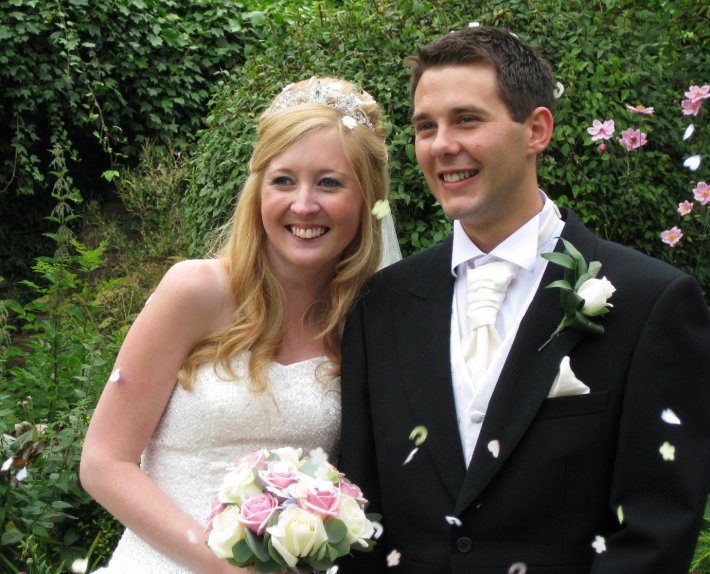 |
| |
|
Claire and Arlo
|
| |
 |
| |
|
Jordan Frampton, Matthew Wethers and Shane Parker.
Arlo and Mathew have been best friends since childhood
|
| |
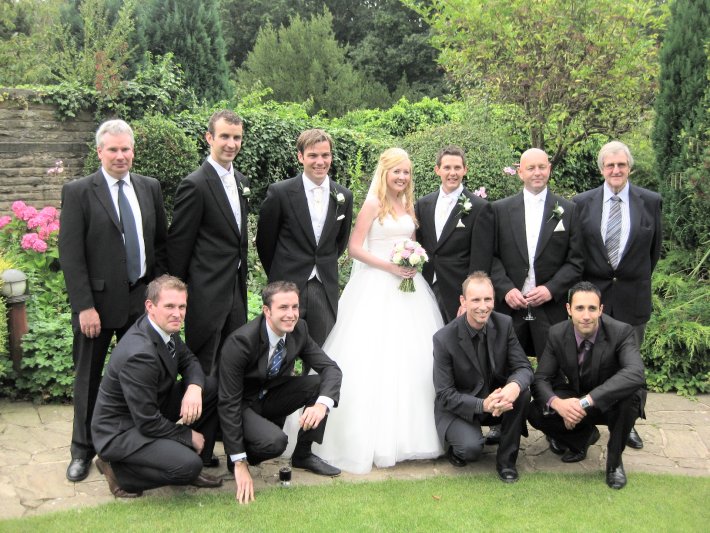 |
| |
| This photograph includes Matthew Wethers (best man), Jordan
Frampton, Shane Parker, Jade Mudgway, Paul Cooper, Jitendra Duffil, and
Barry Simpson (Redcar starting marshall) |
| John says: Best wishes go to Claire and Arlo |
| |
| |
|
| |
| |
|
Ukraine Speedway Rovno
|
| |
| Igor
Sokolovskiy says:
Hi John,
I hope that you may be interested. Best regards, Igor Sokolovskiy. Ukraine, Rovno.
|
|
|
Hi, my name is Igor Sokolovskiy.
I
live in Ukraine, Rovno. |
|
Speedway in our city came in 1959
when in Rovno was opened the first in the Soviet Union a special
stadium for races |
|
on speedway.
It is Rovno in his debut in speedway Viktor
Trofimov, and it happened
April 30, 1960.
He
appeared in 1962 in the USSR national team 15 times in a row started
in the Individual World Championships.
|
| |
I do
statistics Rovno speedway, and I can
clarify about one race in England next.
June 9, 1976 the USSR national team played its third match in England.
On the
track at Belle Vue Aces were stronger.
But the items in the guests a little incorrect.
Vladimir
Paznikov claimed in the race for number 8, three starts in
place of Nikolai
Kornev.
But all the time, finished fourth.
That he is pictured in the fight against Kristian Praestbro.
But Viktor
Kuznetsov - teammate Vladimir
Paznikov in Novosibirsk Sibir',
then do not got 2, and 3 points.
The remaining riders are
unchanged. |
| |
|
|
|
| |
| |
|
Ronnie Hynd's
1940/50s Pictures
|
| |
 |
| |
|
Ken Le Breton, Arthur Forest and Bruce Semmons. A great shot showing
Arthur's steel shoe circa 1940/50's
|
| Ken seen here wearing
Ashfield Jacket, left Newcastle for Glasgow Ashfield Giants in
1949 and died in 1951 so this photo must have been 1949-1950 |
| |
| |
|
Dick Campbell & Jack Young
|
| |
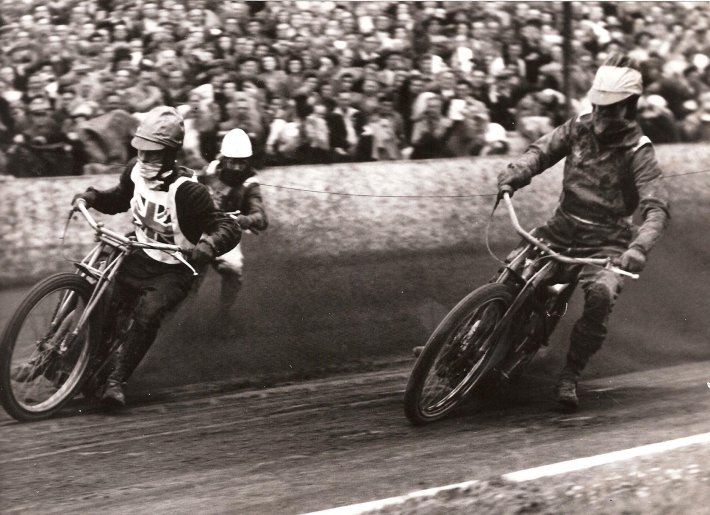 |
| |
| |
|
| |
| |
|
Rocket Bike
!
|
| |
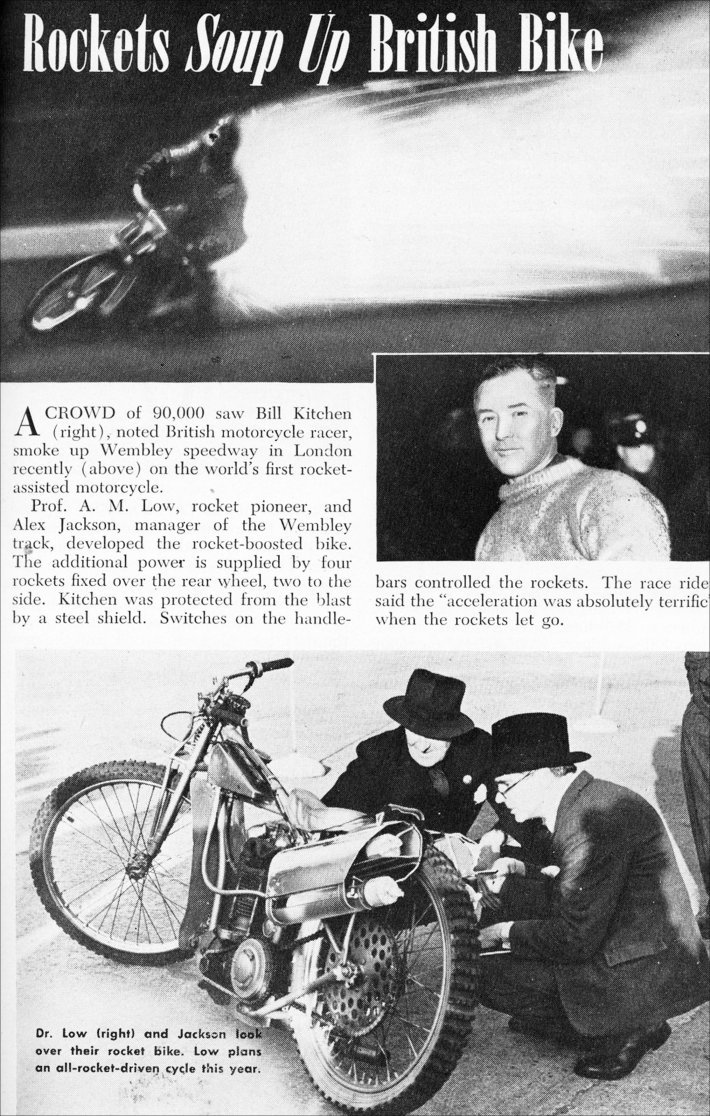 |
| |
| |
 |
| Courtesy of Graham Gleave |
| |
| |
|
| |
| |
| The Crocker
USA |
| |
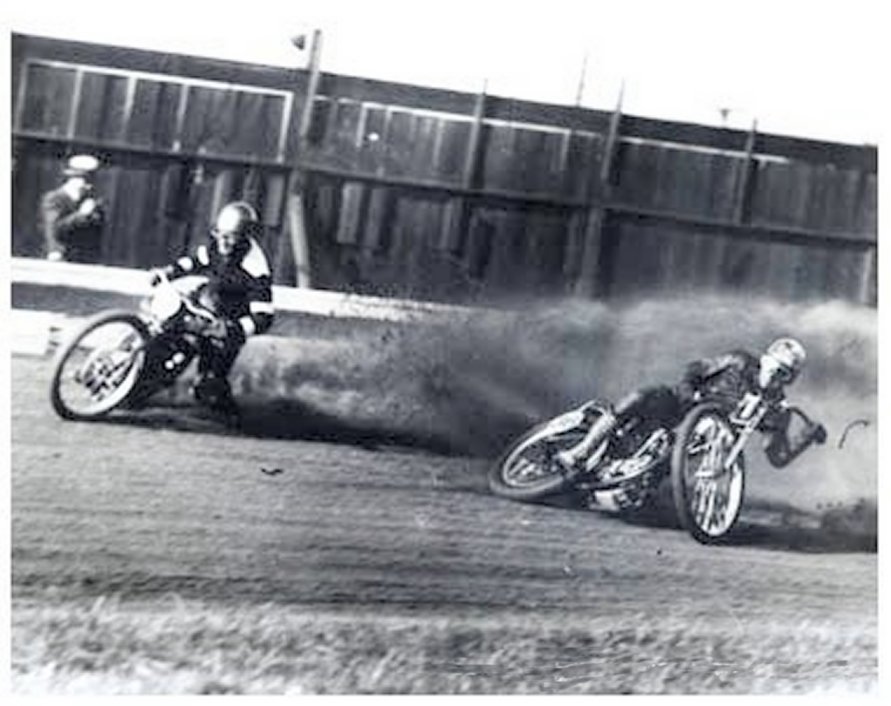 |
| |
|
I think this picture is pre war USA showing a Crocker apparently locking
up
|
| |
| |
|
| |
| |
| Speedway News Thrills &
Spills |
| |
 |
| |
|
Above item courtesy of Jim Henry
|
|
|
|
|
|
|
|
|
|
|
Italian Tourists |
|
|
Hello I am Rocco from Italy, i
remember in 1979/1980/1981 the Italy
Team he came to England to play test
match, the riders were Mauro
Ferraccioli, Fausto Birbini,
Francesco Biginato, Mario Andriolo
etc..
you want to know if you have
photos or articles about it.
Mauro win a race in england but
i d'ont know where?
Thanks. Mauro Ferraccioli was my
brother-in-law unfortunately on
January 31st 2019 he died because of
cancer he was 63 years old. Rocco
Oltramari
|
|
|
|
John says: I don't think the Italian riders came anyway near
my native north east of England around 1979 or the early 1980s.
Rocco would be pleased to hear from anyone whom has any pics
programmes etc. If you can help him out his email is
roccodamiano@yahoo.it
|
|
|
|
Rocco sent me the following images |
|
|
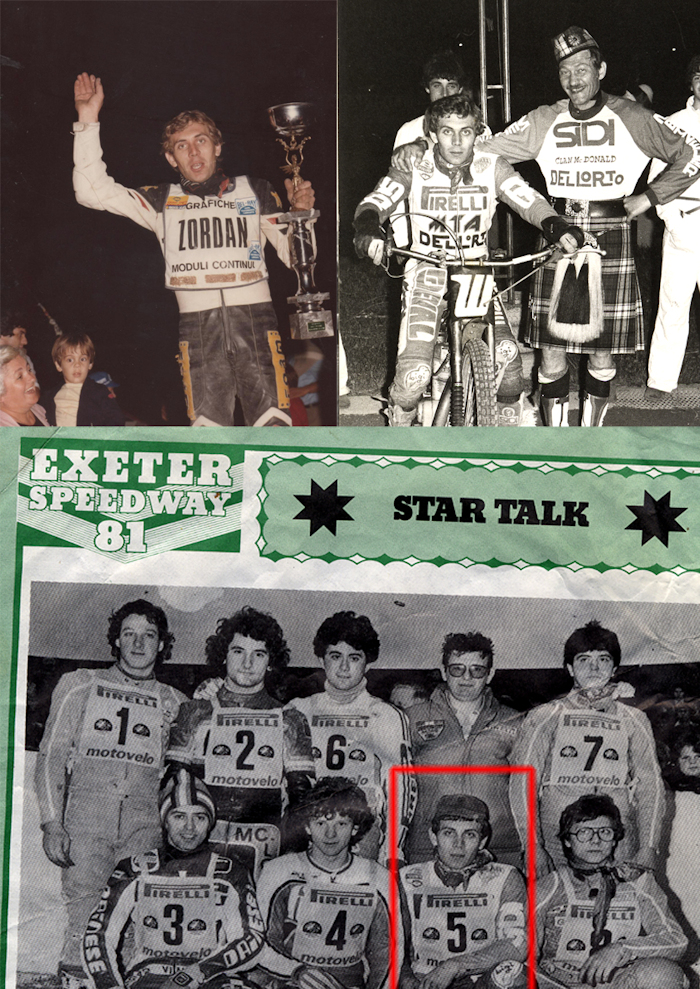 |
|
Courtesy of Rocco Oltramari |
|
|
|
|


 |
|
Courtesy of Rocco Oltramari |
|
|
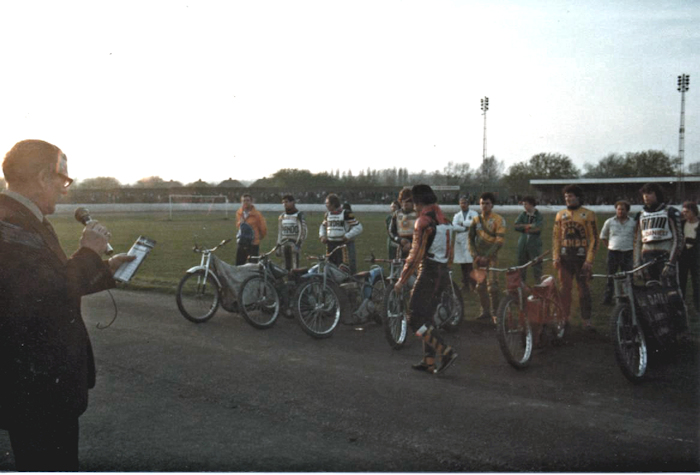 |
|
Courtesy of Rocco Oltramari |
|
|
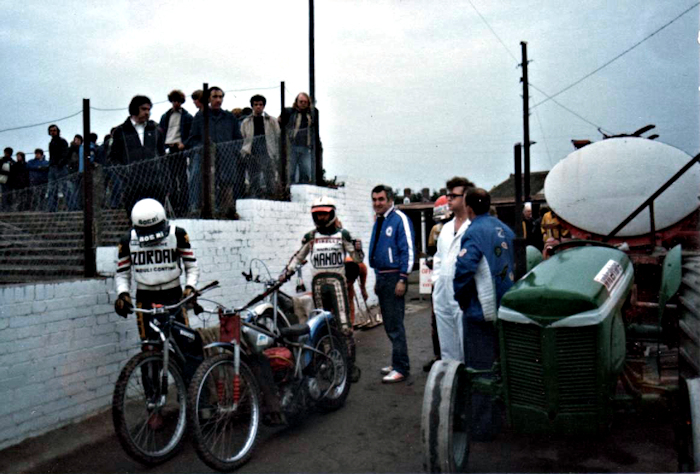 |
|
Courtesy of Rocco Oltramari |
|
|
 |
|
Courtesy of Rocco Oltramari |
|
|
|
|
|
|
|
|
|
|
Polish Tourists 1956 |
|
|
 |
 |
|
|
|
|
|
John says if you have memories/programmes or photos about these
Italian/Polish trips to the UK then please get in touch
John |
|
|

